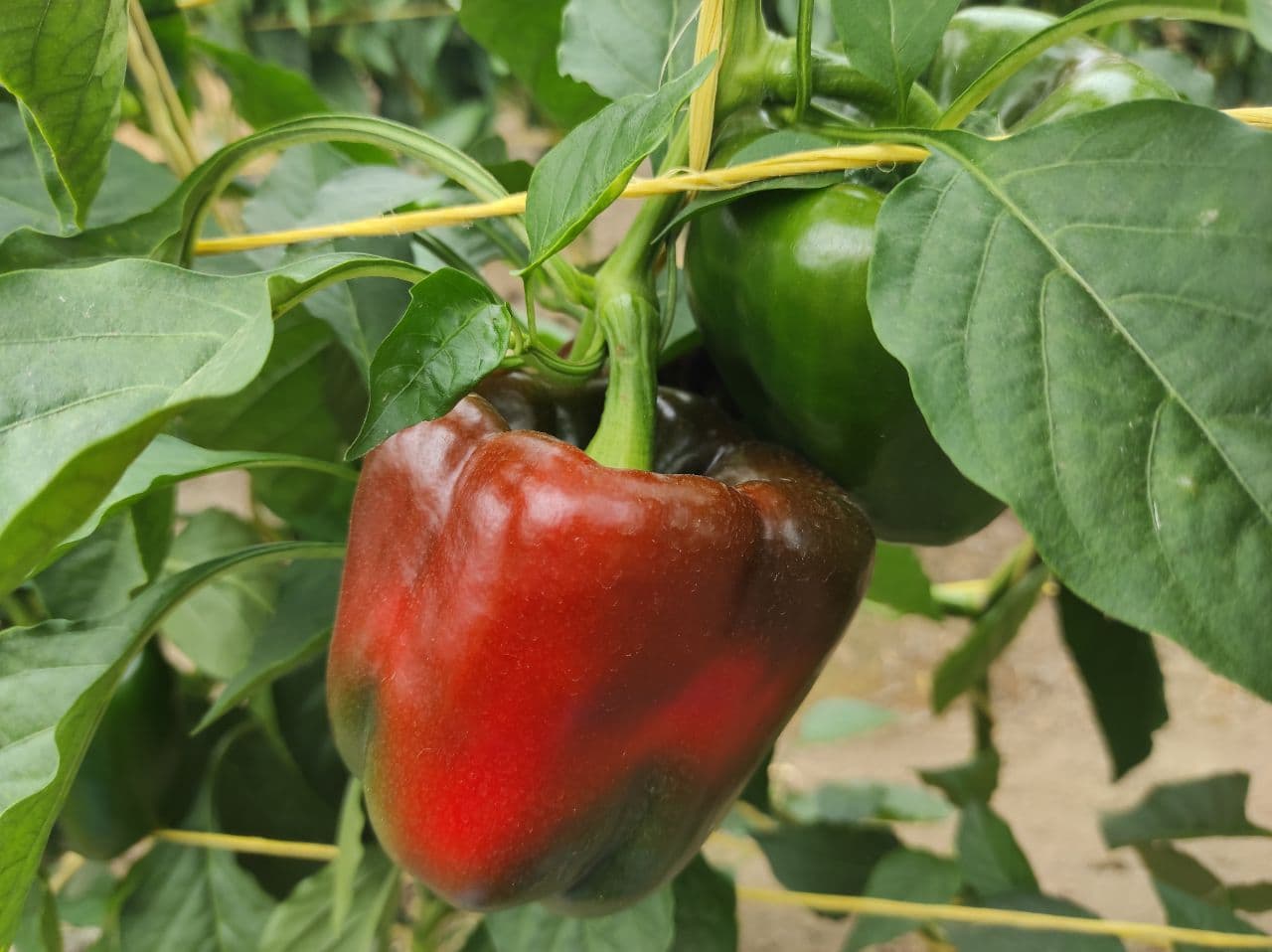
English - Español
La semana pasada nuevamente visitamos una plantación de pimentones, la primera vez que lo hicimos fue en un invernadero que estaba plantado recientemente y las plantas estaban muy pequeñas. Esta vez hemos vuelto al mismo sitio exactamente 1 mes después a ver como va el proceso, además de eso entramos a un invernadero que tiene 3 o 4 meses desde que fue plantado y ya está siendo cosechado, la cosecha de pimentones se hace 1 vez a la semana y en un ambiente controlado, con temperatura y control de plagas adecuada las plantas suelen ser cosechadas 10-14 veces, es decir aproximadamente 4 meses, incluso hay ocasiones que este tiempo se extiende a 5 o 6.
En mi familia siempre hemos querido laborar en el campo, y tener nuestro propio cultivo, así que esta vez por fin hemos logrado este objetivo y esta semana comenzaremos los preparativos para tener todo listo en los próximos días, la idea de este recorrido fue instruirnos un poco mas en este medio, para saber los gastos que tendremos, las ganancias y que tan difícil es mantener un cultivo de pimentones, además para aprender un poco sobre los fertilizantes y que todo tenga el mejor cuidado.
En mi anterior post, mostré algunas imágenes de como se veía todo al principio.
Sinceramente no tuve que entrar al invernadero para ver el cambio tan radical que tenía 1 mes después, simplemente desde afuera ya se podían ver las plantas con un tamaño mucho mayor, pimentones muy pequeños en proceso de crecimiento, con abundantes hojas y flores. Jamás me imagine que el proceso de crecimiento de estas plantas fuera tan rápido, además que en invernadero tu tamaño en 10 veces mayor a las plantaciones en campo abierto.
Mi primo me cuenta, que normalmente el tamaño de estas plantas es un poco mas pequeño, lo que sucedió es que el abono la tierra con un fertilizante natural que no muchos suelen utilizar, es una mezcla entre hojas de arroz, excremento de gallina, caballo y otras cosas mezcladas y molidas, de tal manera que parece un polvo muy fino, este fertilizante ayuda al crecimiento de cualquier cultivo y ya esta comprobado científicamente, además que no daña el suelo como los fertilizantes químicos.
Las plantas tiene aproximadamente y 1 mes y 2 semanas o un poco mas desde que fueron plantadas en el suelo, y hay algunas que ya están comenzado a soltar su primera cosecha de pimentones, algunos tiene un tamaño muy grande que pueden hacer que la planta muera debido al peso que tienen, es por esto que se amarran desde el techo para que los frutos cuelguen y no hagan un contrapeso que dañe a la planta, todo aquí esta controlado y es por ello que se obtiene el 90% de calidad, además de un tamaño 3 veces mayor al habitual y un color realmente atractivo.
Last week we again visited a plantation of paprika, the first time we did it was in a greenhouse that was recently planted and the plants were very small. This time we have returned to the same place exactly 1 month later to see how the process is going, besides that we entered a greenhouse that has 3 or 4 months since it was planted and is already being harvested, the harvest of paprika is done once a week and in a controlled environment, with proper temperature and pest control the plants are usually harvested 10-14 times, that is approximately 4 months, there are even times that this time is extended to 5 or 6.
In my family we have always wanted to work in the field, and have our own crop, so this time we have finally achieved this goal and this week we will begin preparations to have everything ready in the coming days, the idea of this tour was to instruct us a little more in this environment, to know the expenses we will have, the profits and how difficult it is to maintain a crop of peppers, also to learn a little about fertilizers and that everything has the best care.
In my previous post, I showed some pictures of how everything looked at the beginning.
Honestly I did not have to enter the greenhouse to see the radical change that I had 1 month later, just from the outside you could see the plants with a much larger size, very small peppers in the process of growth, with abundant leaves and flowers. I never imagined that the growth process of these plants would be so fast, besides that in the greenhouse your size is 10 times bigger than in open field plantations.
My cousin tells me that normally the size of these plants is a little smaller, what happened is that he fertilized the soil with a natural fertilizer that not many usually use, it is a mixture of rice leaves, chicken droppings, horse and other things mixed and ground, so that it looks like a very fine powder, this fertilizer helps the growth of any crop and is already scientifically proven, plus it does not damage the soil as chemical fertilizers.
The plants have approximately 1 month and 2 weeks or a little more since they were planted in the ground, and there are some that are already beginning to release their first crop of peppers, some have a very large size that can make the plant die due to the weight they have, this is why they are tied from the roof so that the fruits hang and do not make a counterweight that damages the plant, everything here is controlled and that is why 90% of quality is obtained, plus a size 3 times larger than usual and a really attractive color.
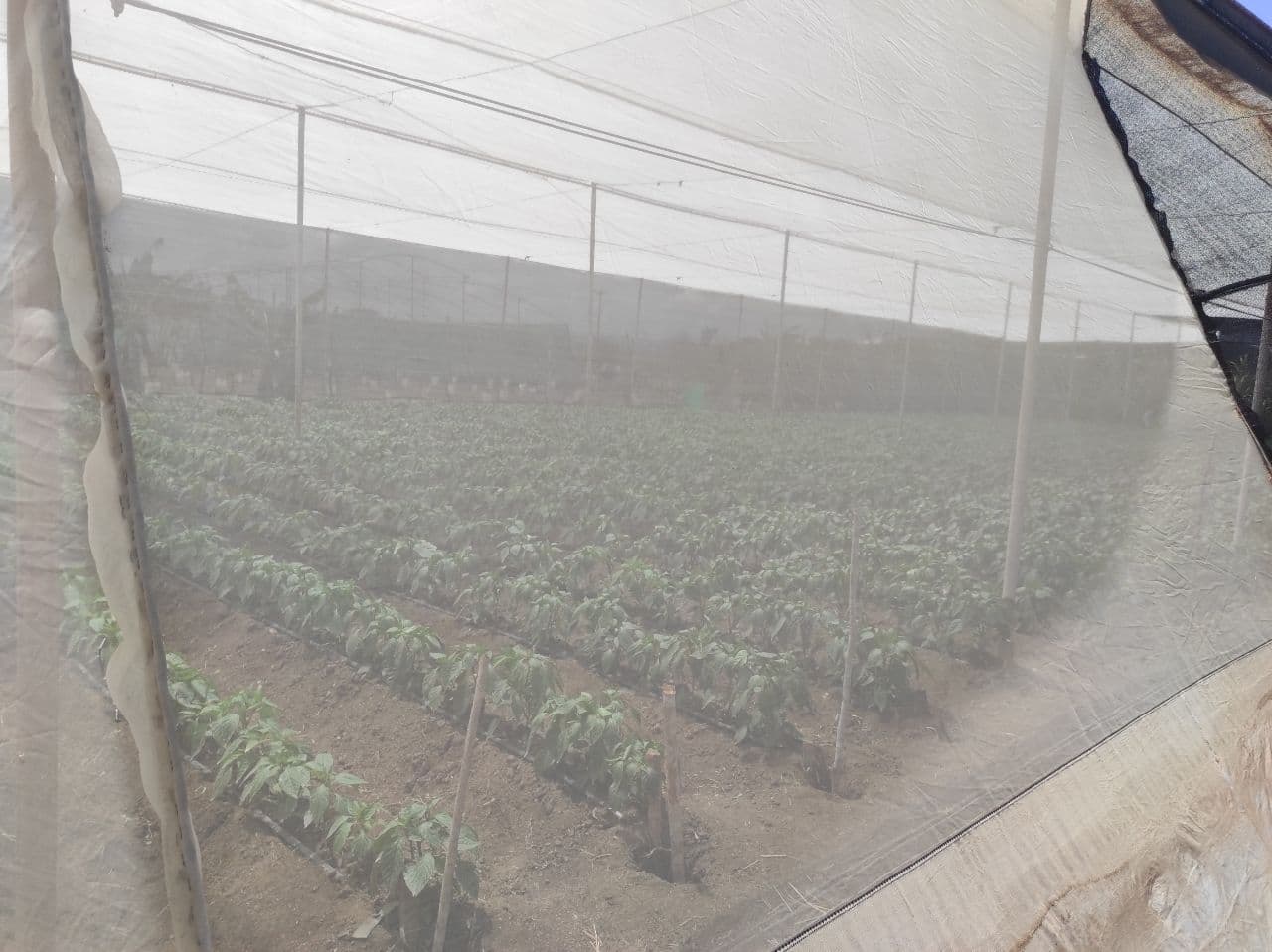
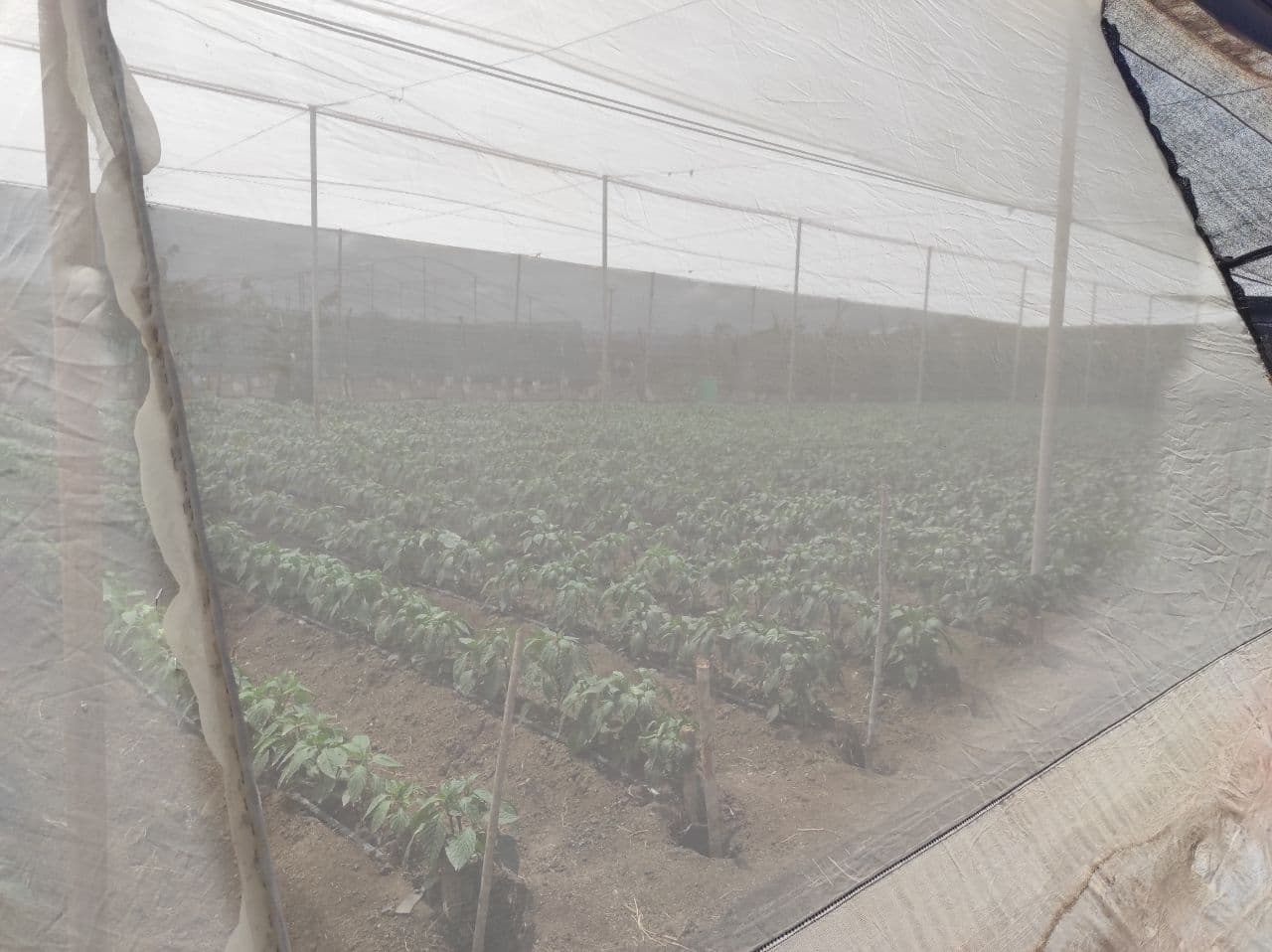
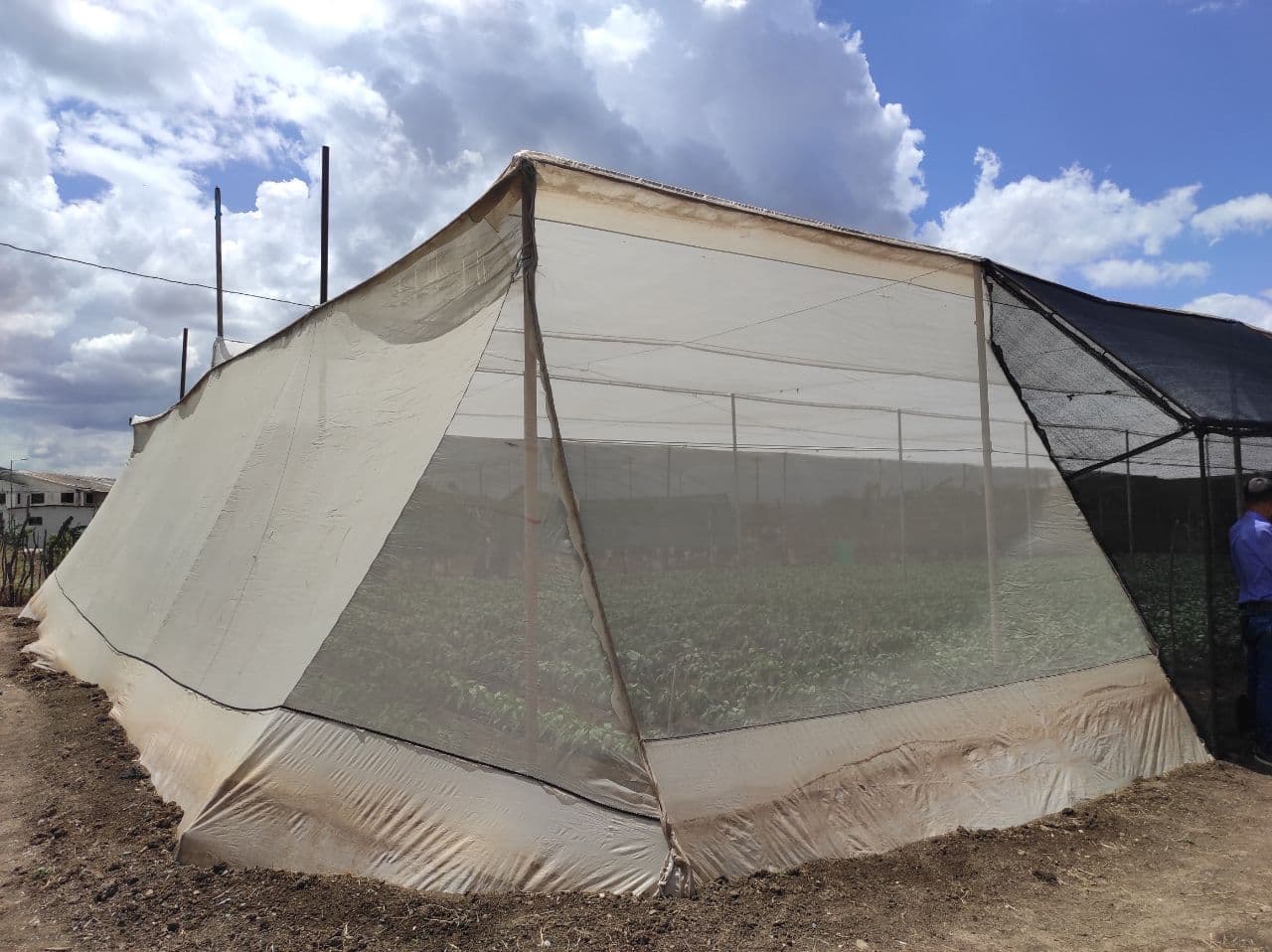
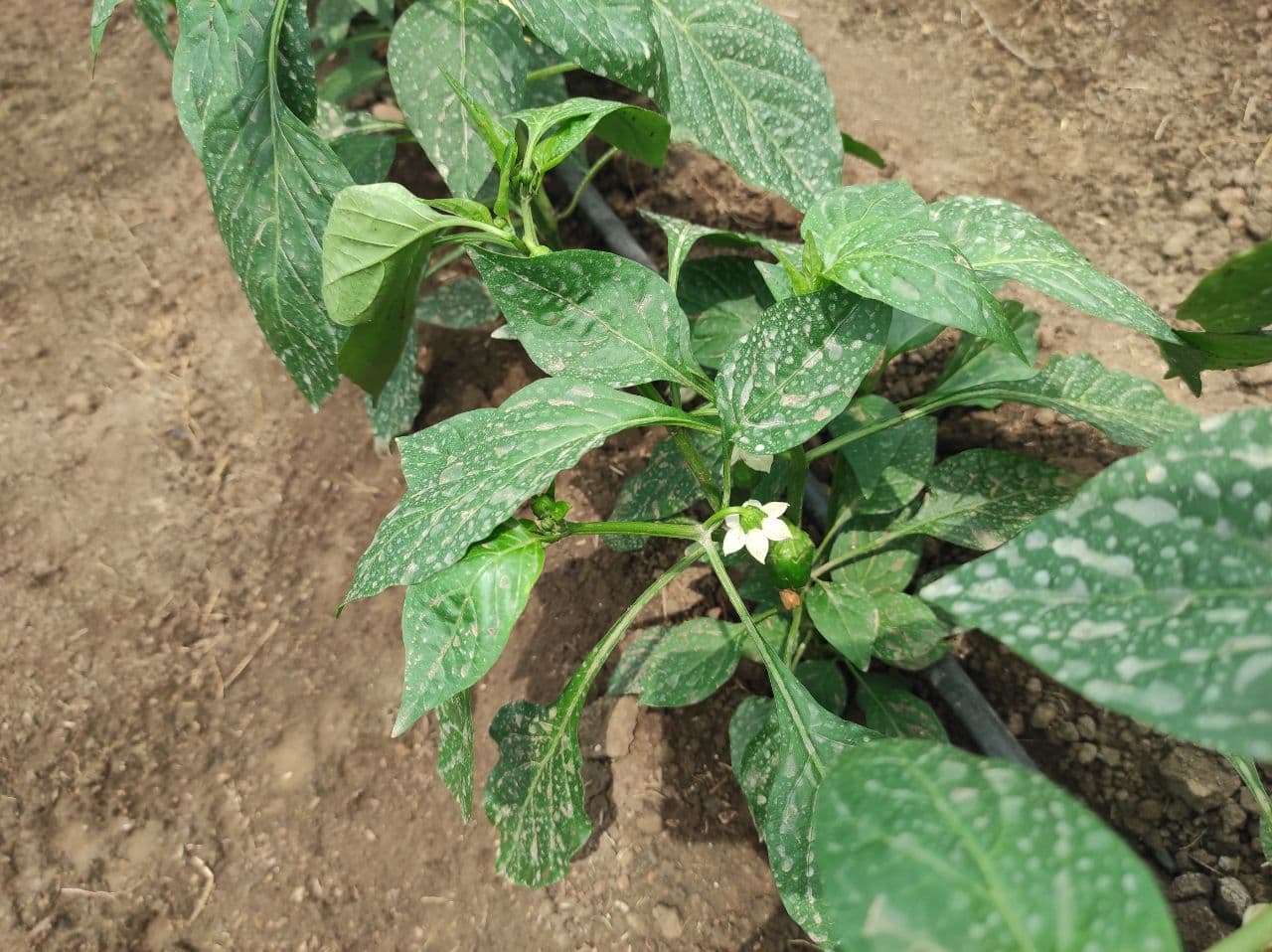

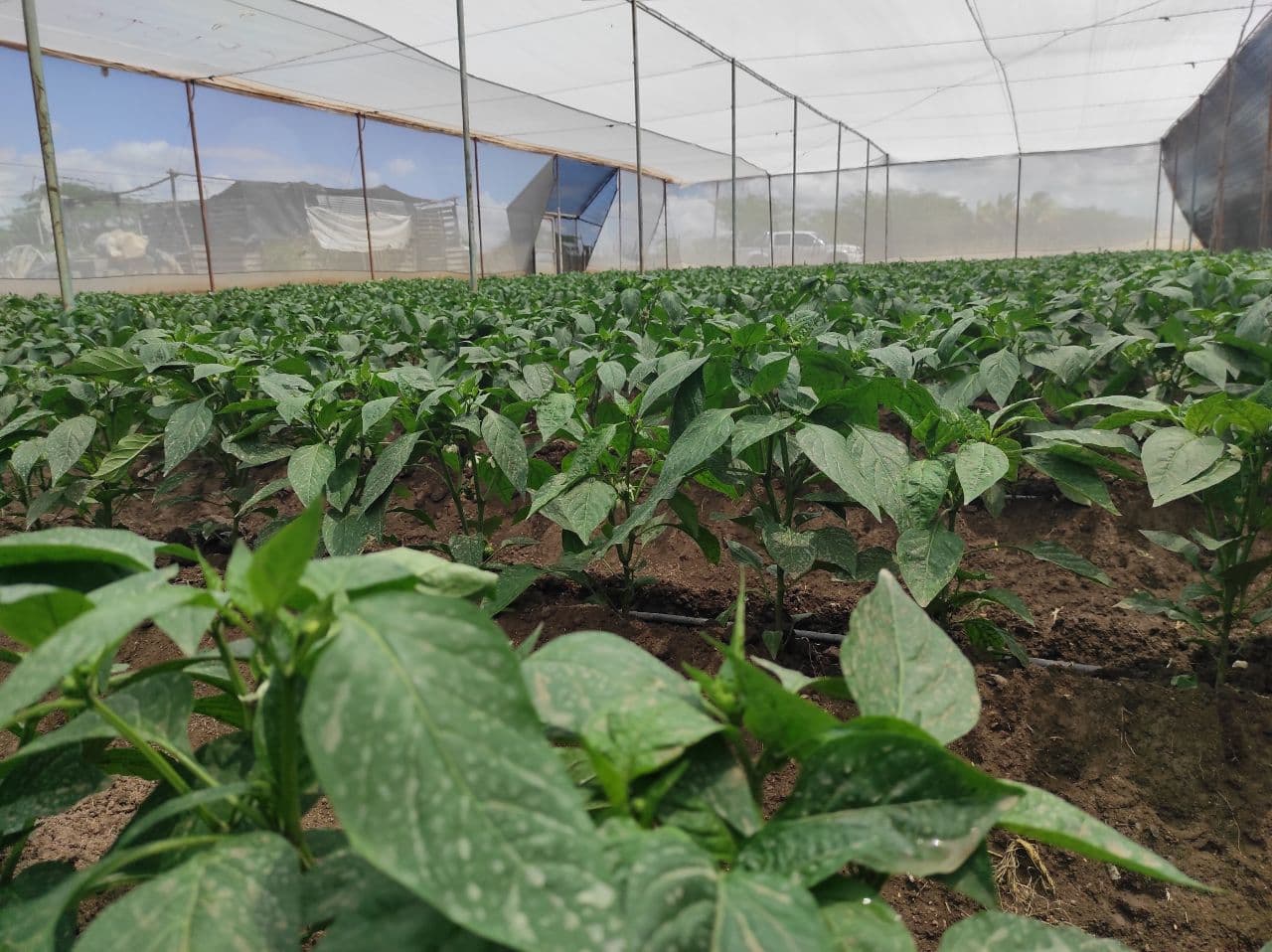
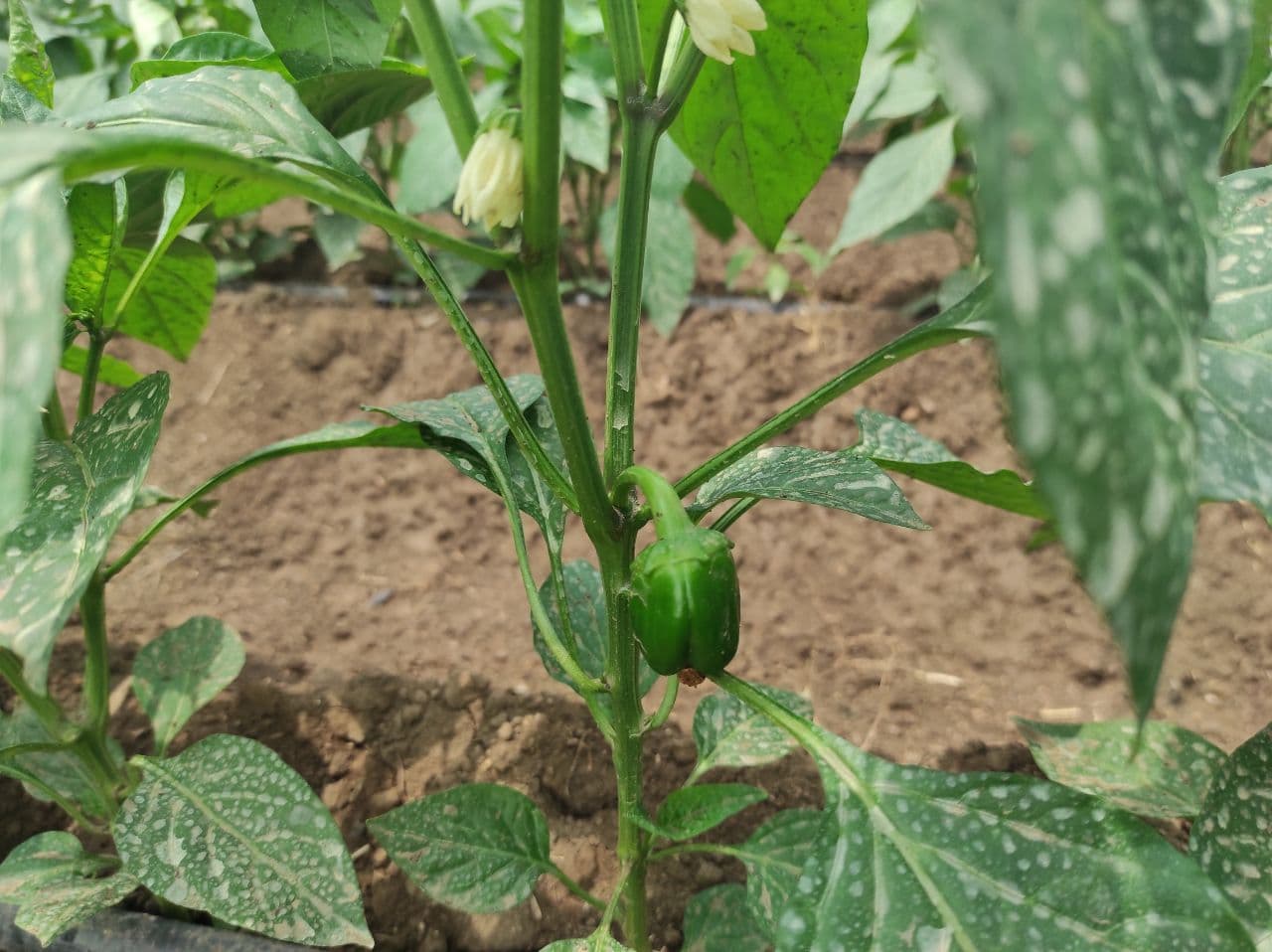
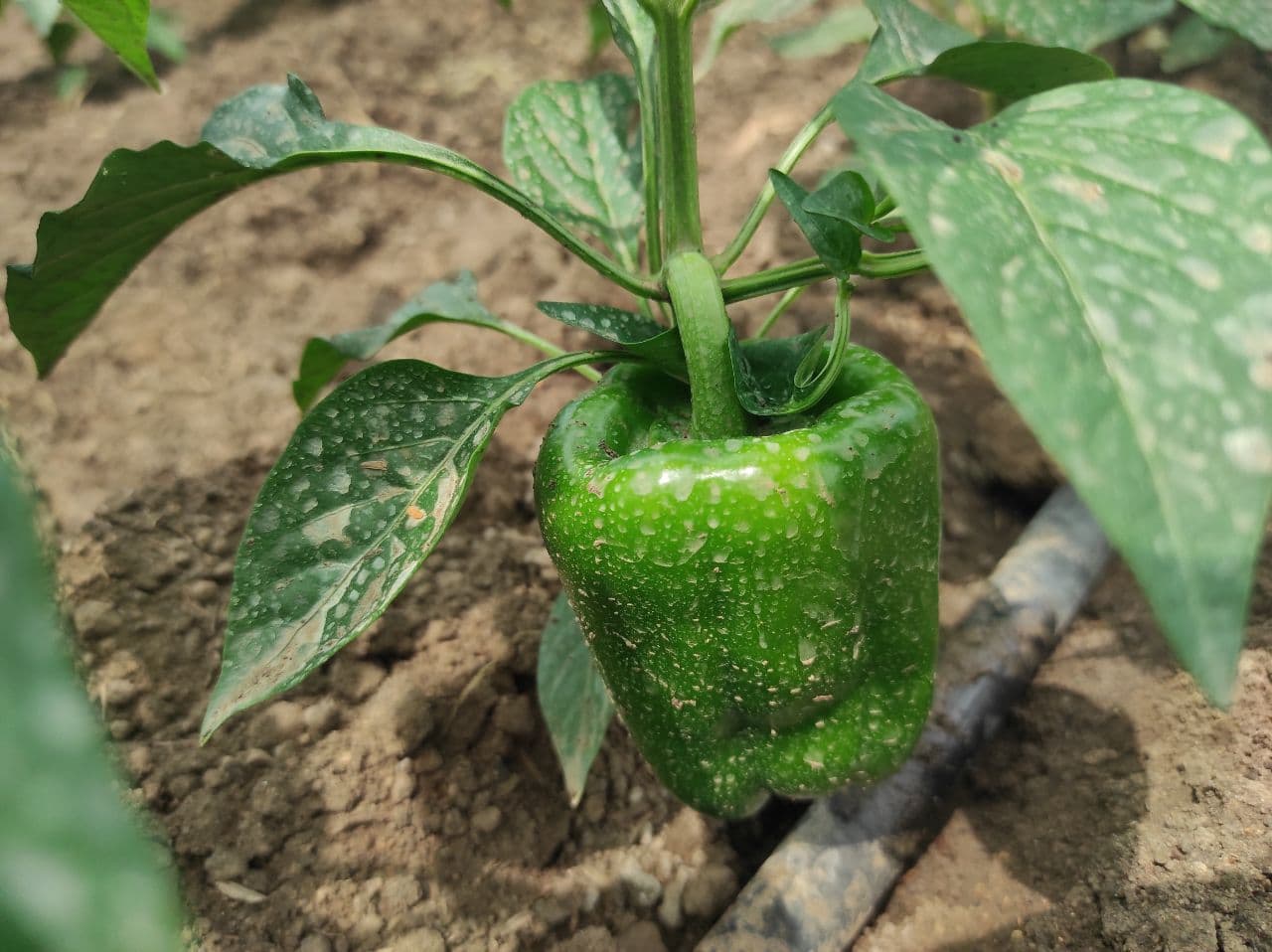
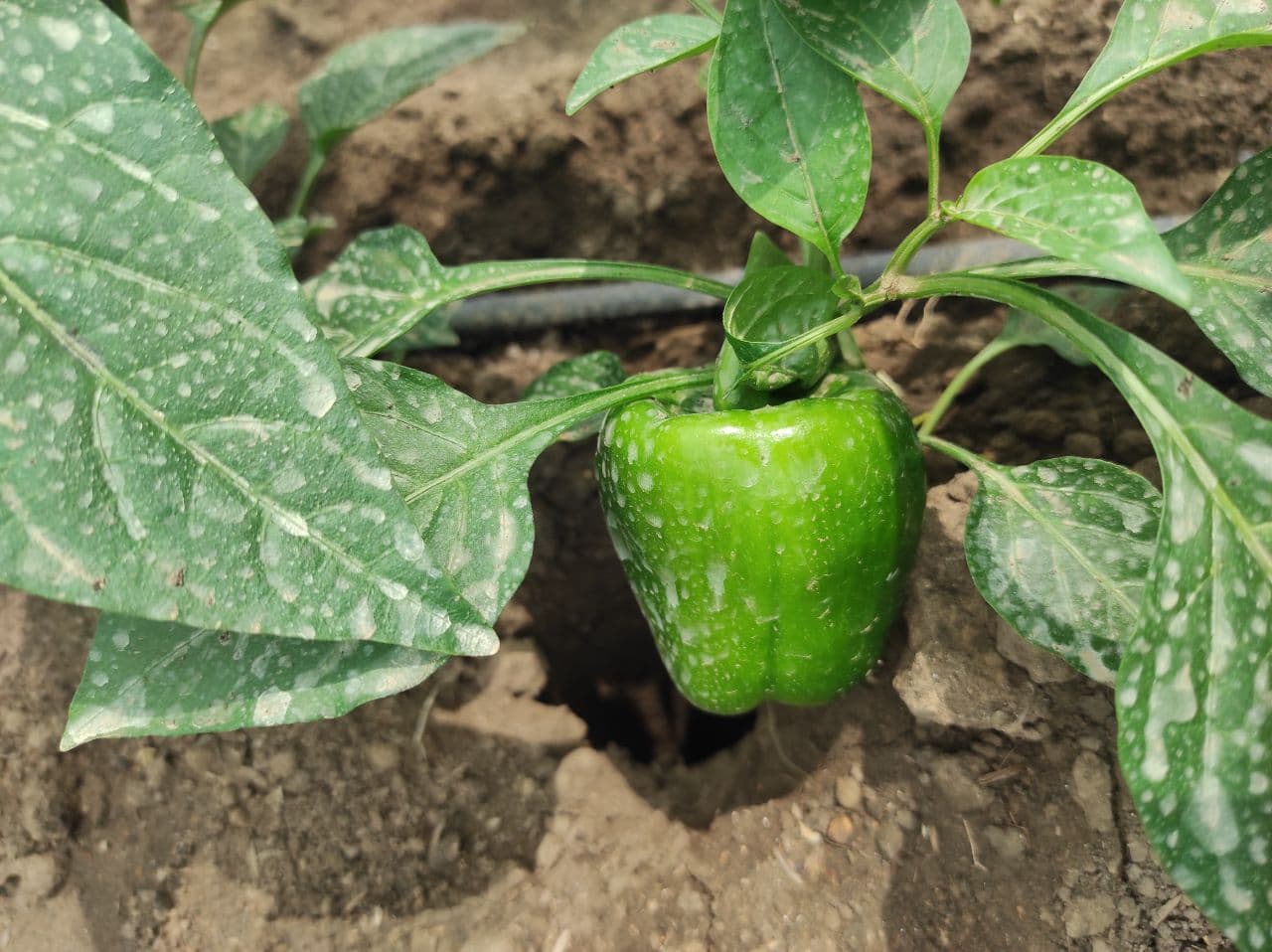
Normalmente en esta instancia las flores de las plantas son recortadas para evitar que los frutos se den mucho antes de lo esperado, lo ideal es que la planta alcance el tamaño deseado antes de comenzar a dar frutos, en muchos lugares las personas piensan lo contrario que es mejor cuando comienza a dar frutos muy pequeña, y están totalmente equivocados, esto lo que hace es que la vida útil de la planta disminuya.
Además de eso la genética de los pimentones es variante, en cuanto a formas y tamaños no se puede asegurar que todos sean iguales, siempre habrá alguno que tenga una forma mucho mas distinta a lo cotidiano, y siempre habrá alguno que sea mucho mas grande que el resto.
Otra cosa muy interesante es que 2 plantas de cada 100, suelen ser "machos", plantas que solo florean pero no dan frutos, y deben ser eliminadas, sinceramente aun no se diferenciarlas, pero las personas que ya tienen años sembrando pimentones se dan cuenta a los días.
Los canales por donde podemos caminar es el espacio preciso para poder cosechar luego, y el procedimiento de abonar la planta se llama "arrimar" que básicamente es dejar un canal de tierra en el centro y mover la tierra al tallo de la planta.
Normally in this instance the flowers of the plants are trimmed to prevent the fruits are given much earlier than expected, the ideal is that the plant reaches the desired size before starting to bear fruit, in many places people think otherwise that it is better when it begins to bear fruit very small, and they are totally wrong, this what it does is that the life of the plant decreases.
In addition to that, the genetics of the peppers is variant, in terms of shapes and sizes can not be assured that all are equal, there will always be one that has a much different shape to the everyday, and there will always be one that is much larger than the rest.
Another very interesting thing is that 2 plants out of every 100, are usually "males", plants that only flower but do not bear fruit, and should be eliminated, honestly I still do not know how to differentiate them, but people who have been planting peppers for years realize it every day.
The channels where we can walk is the precise space to be able to harvest later, and the procedure to fertilize the plant is called "arrimar" which basically is to leave a channel of soil in the center and move the soil to the stem of the plant.
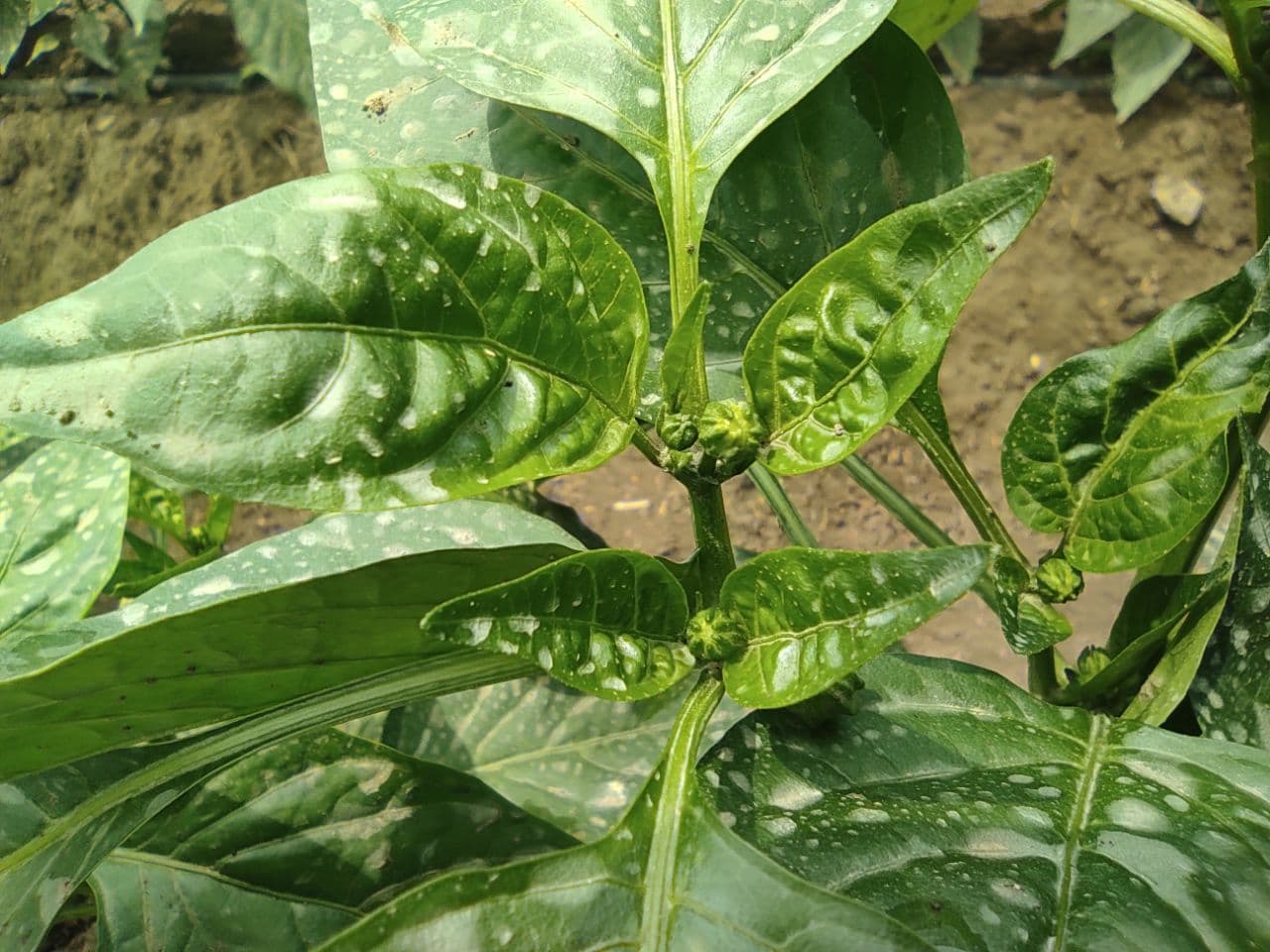

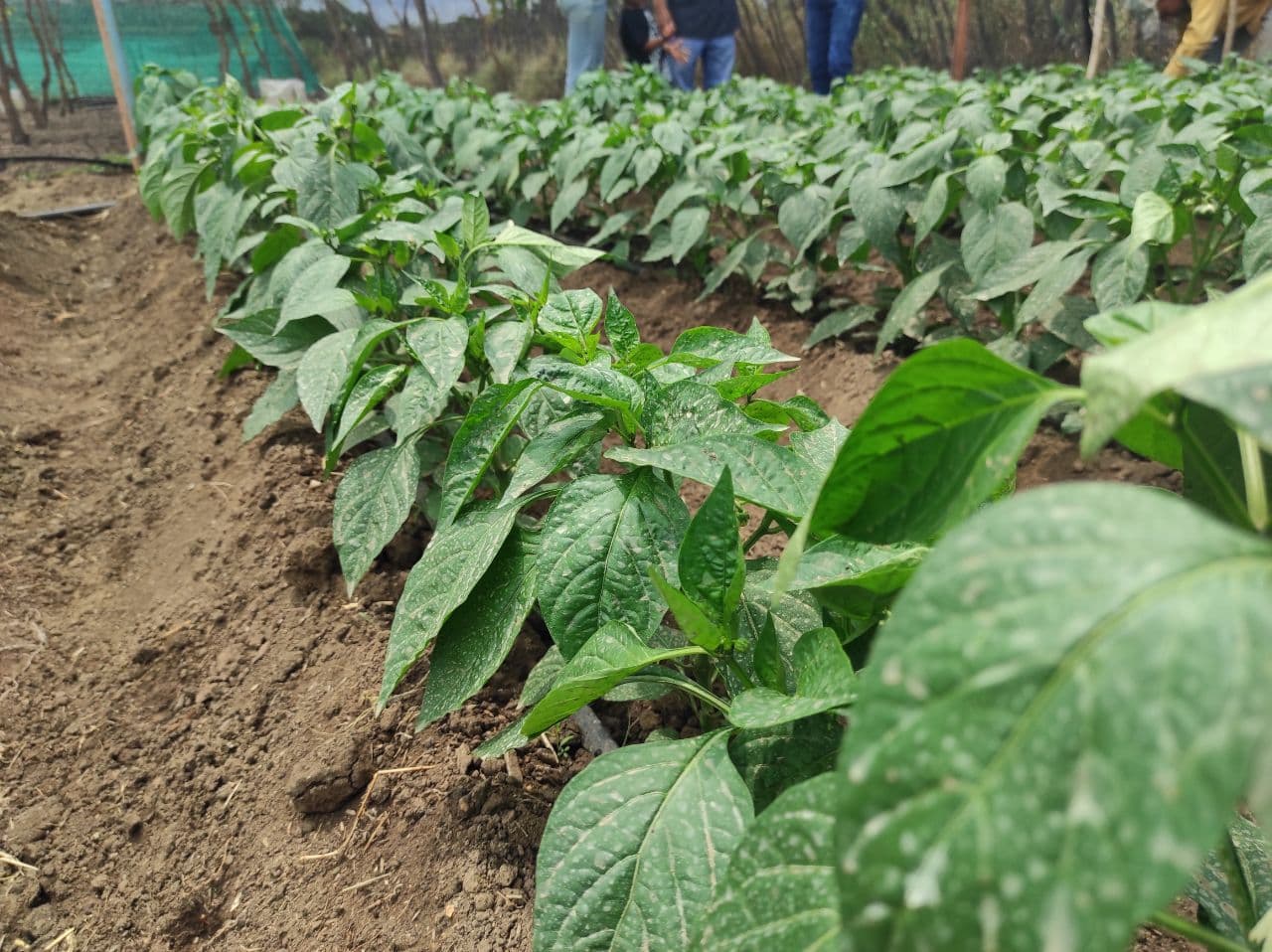
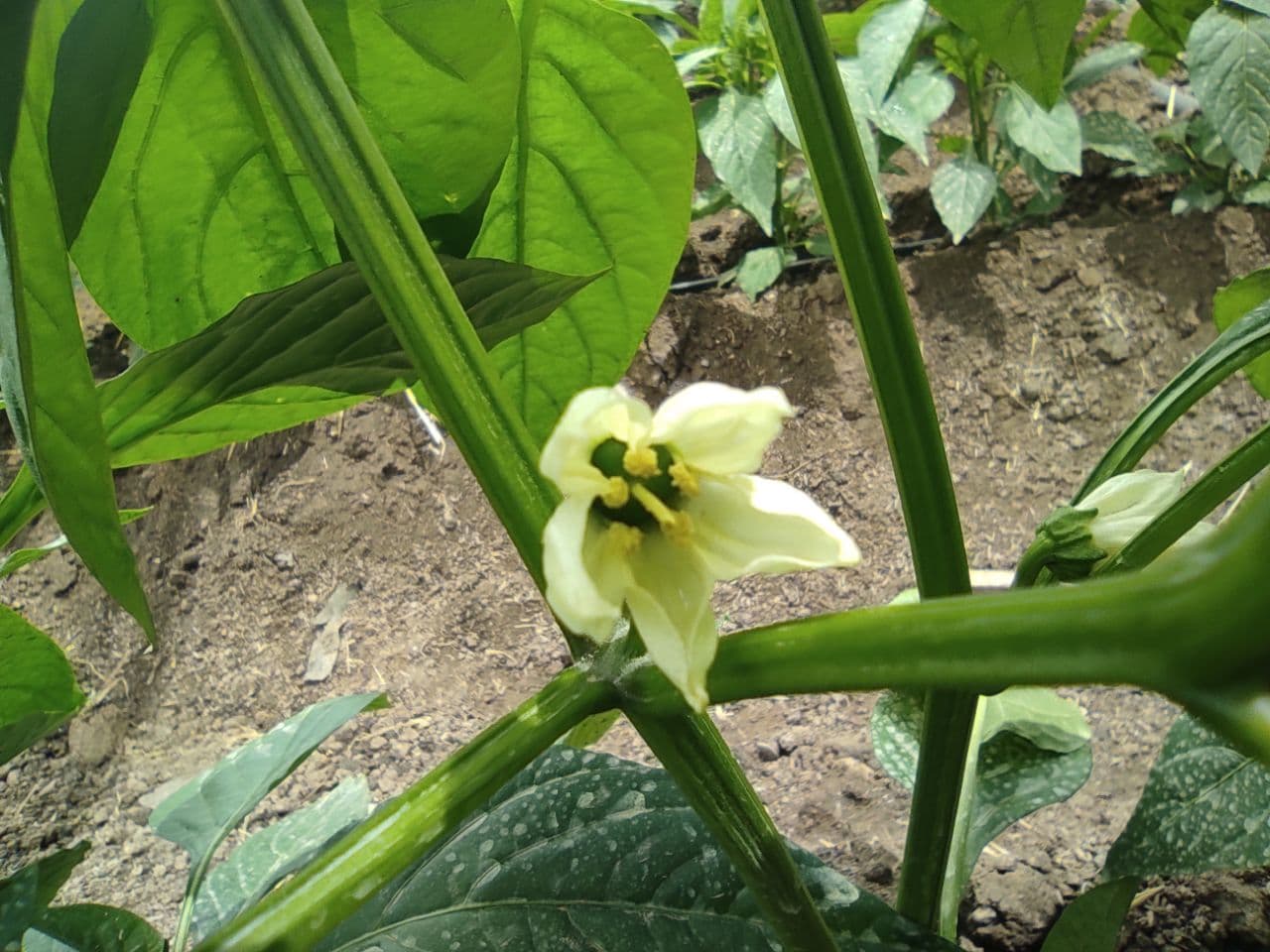
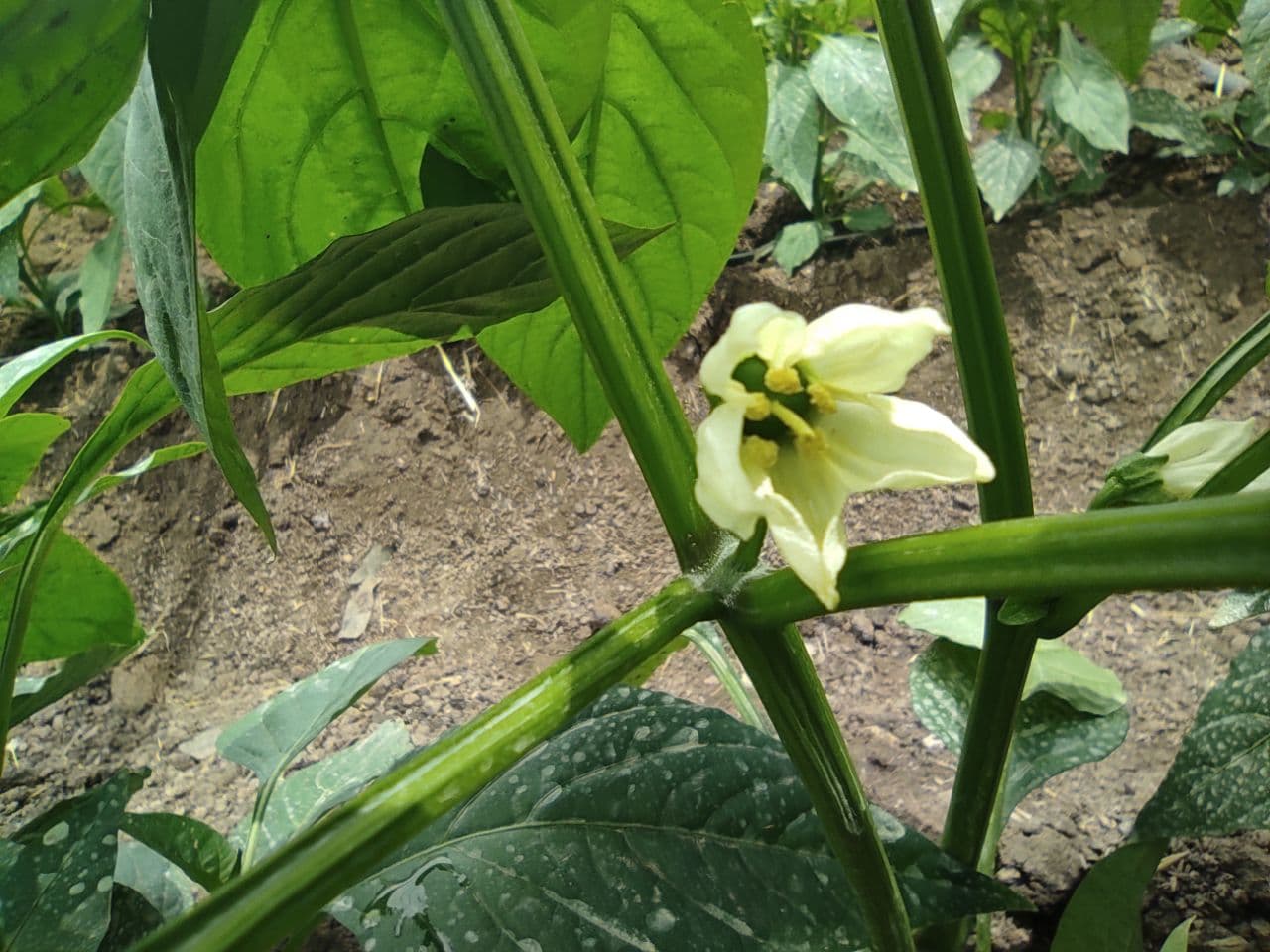
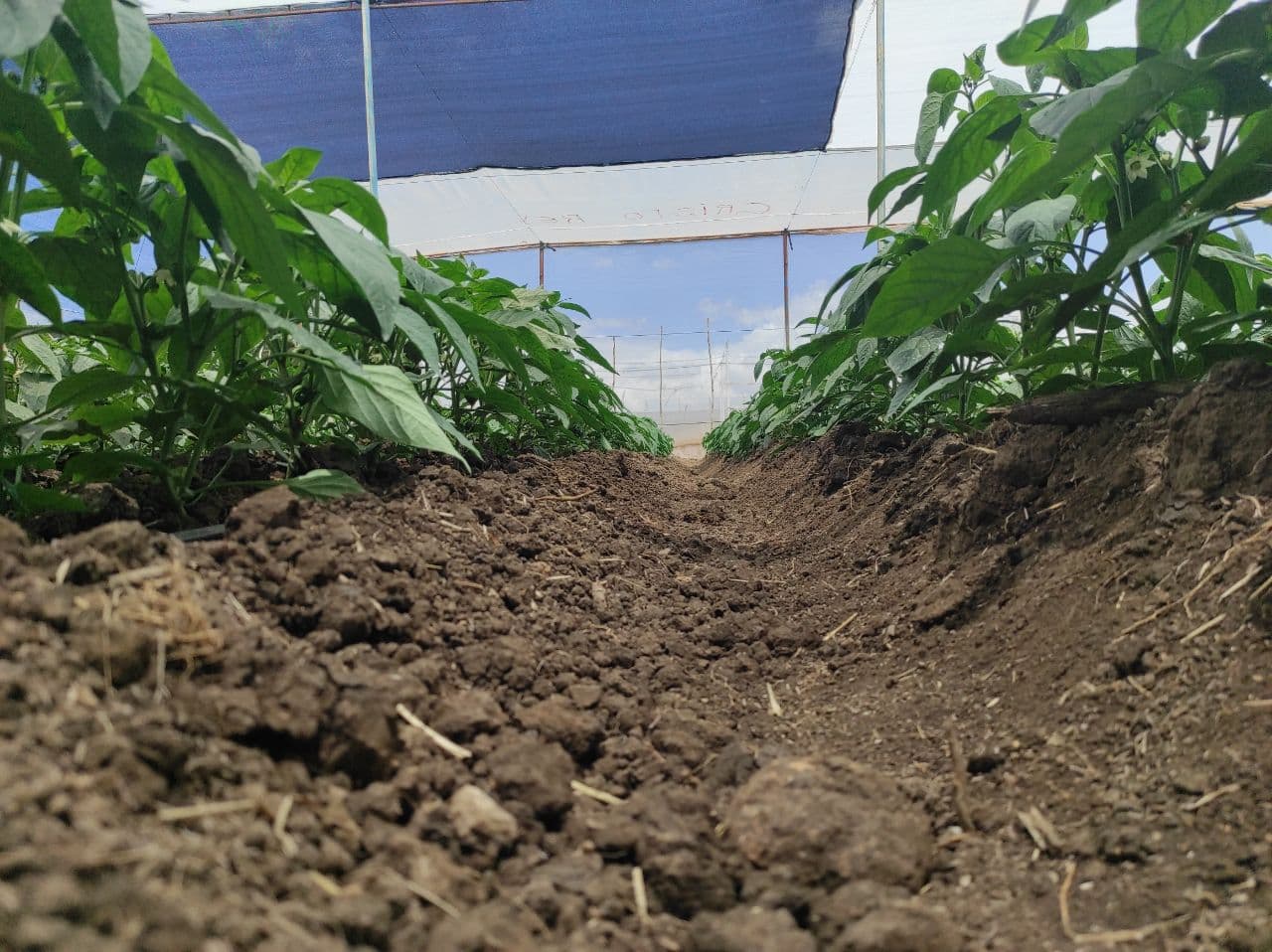
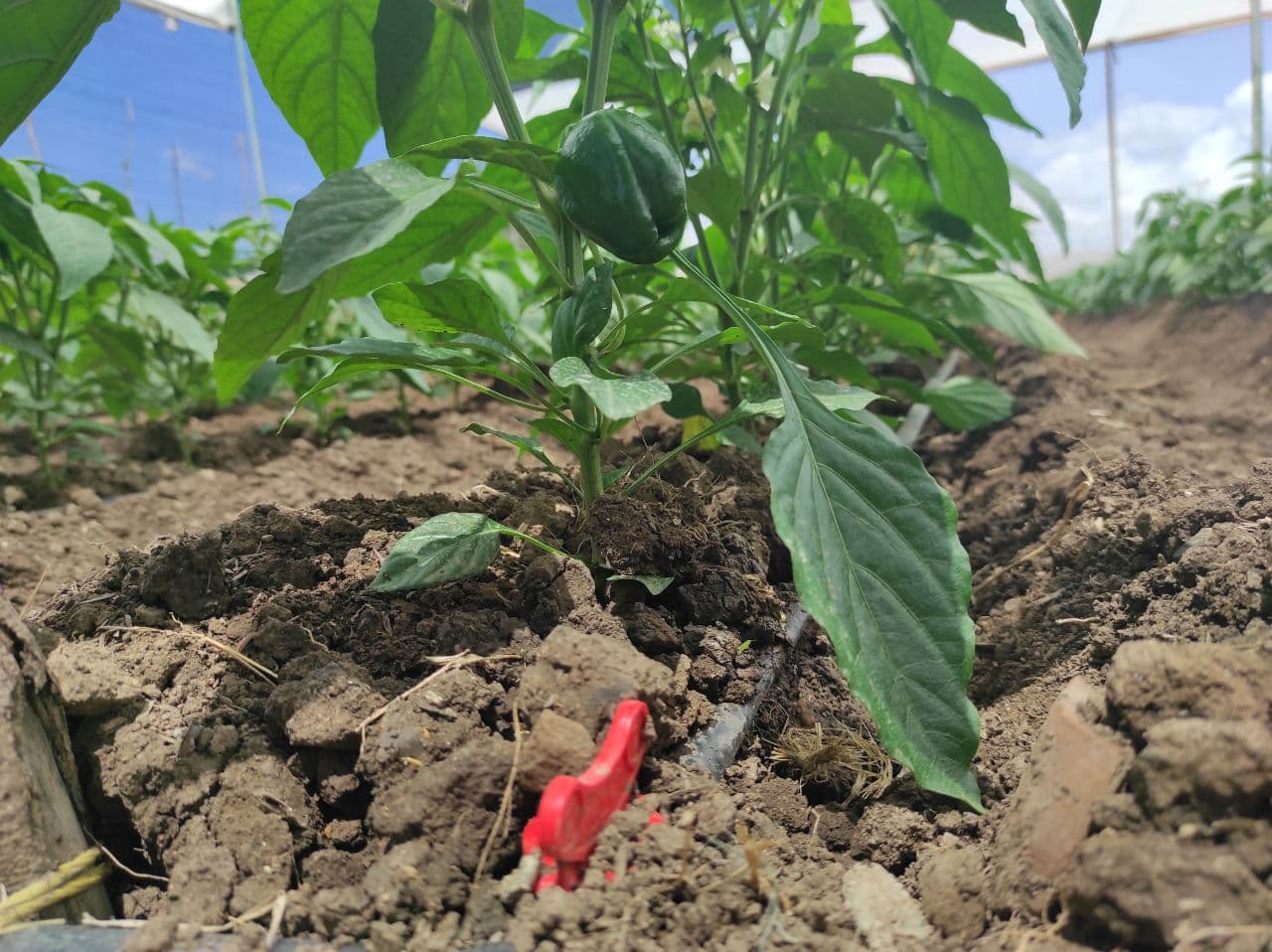
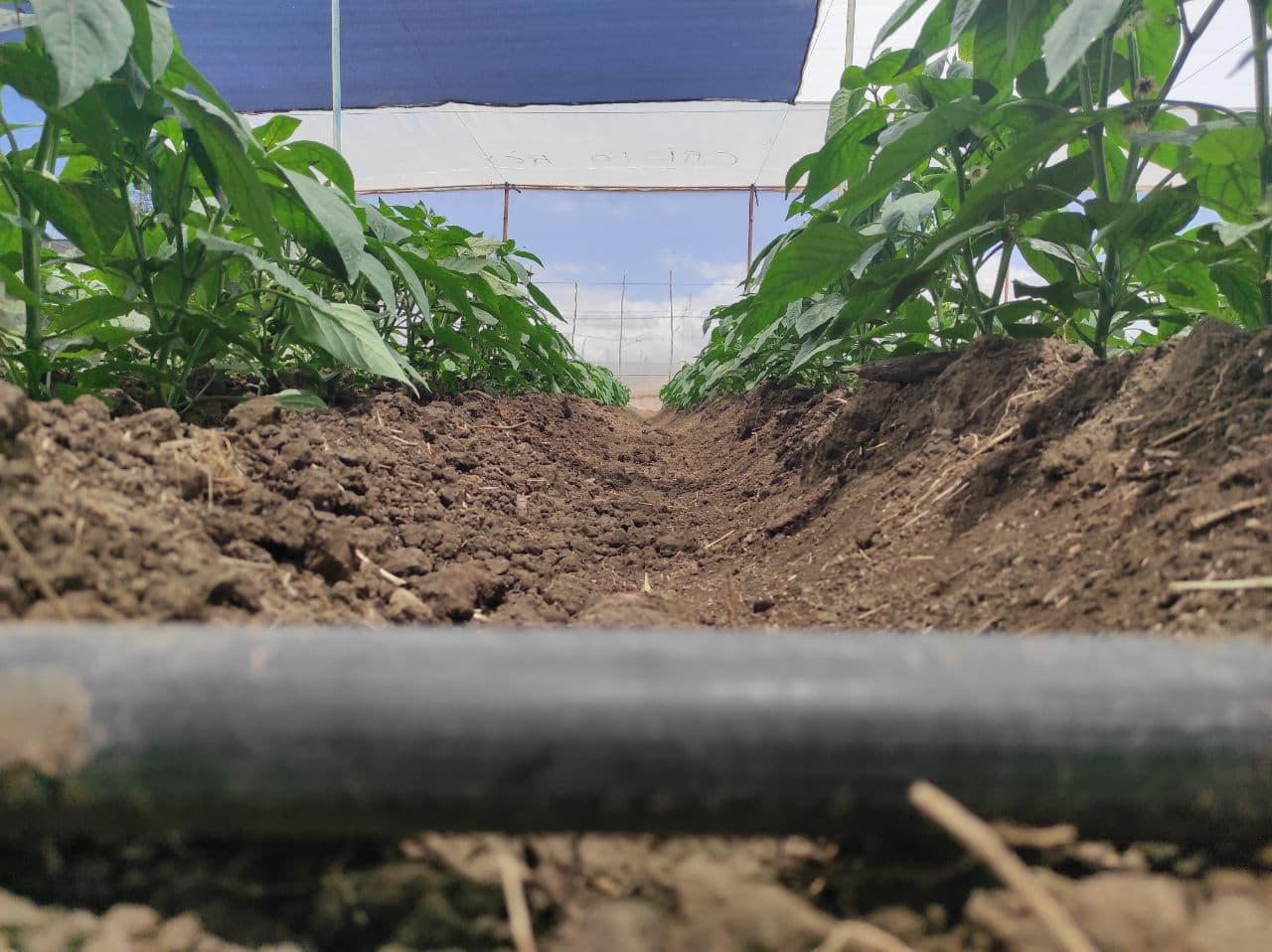
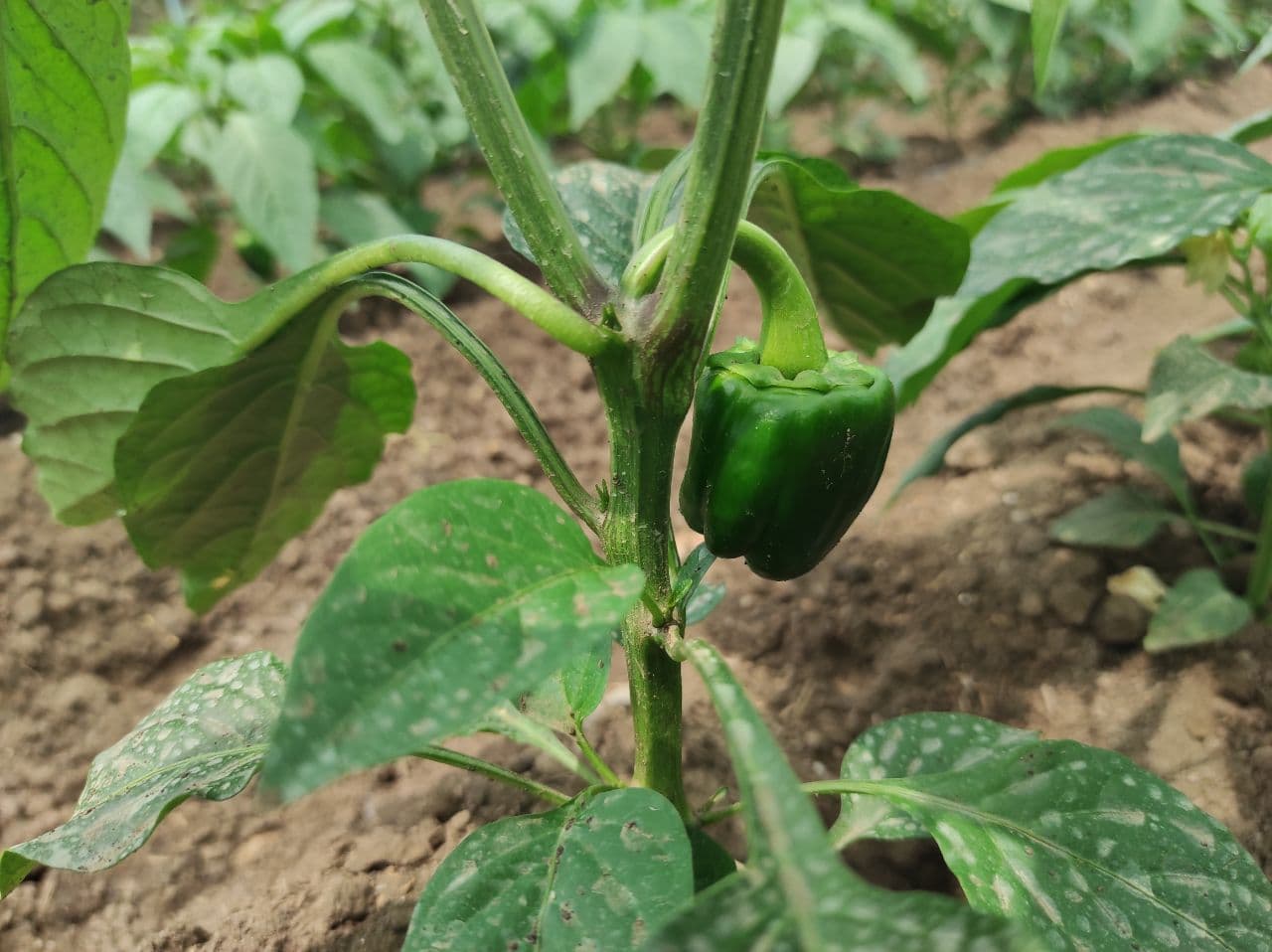


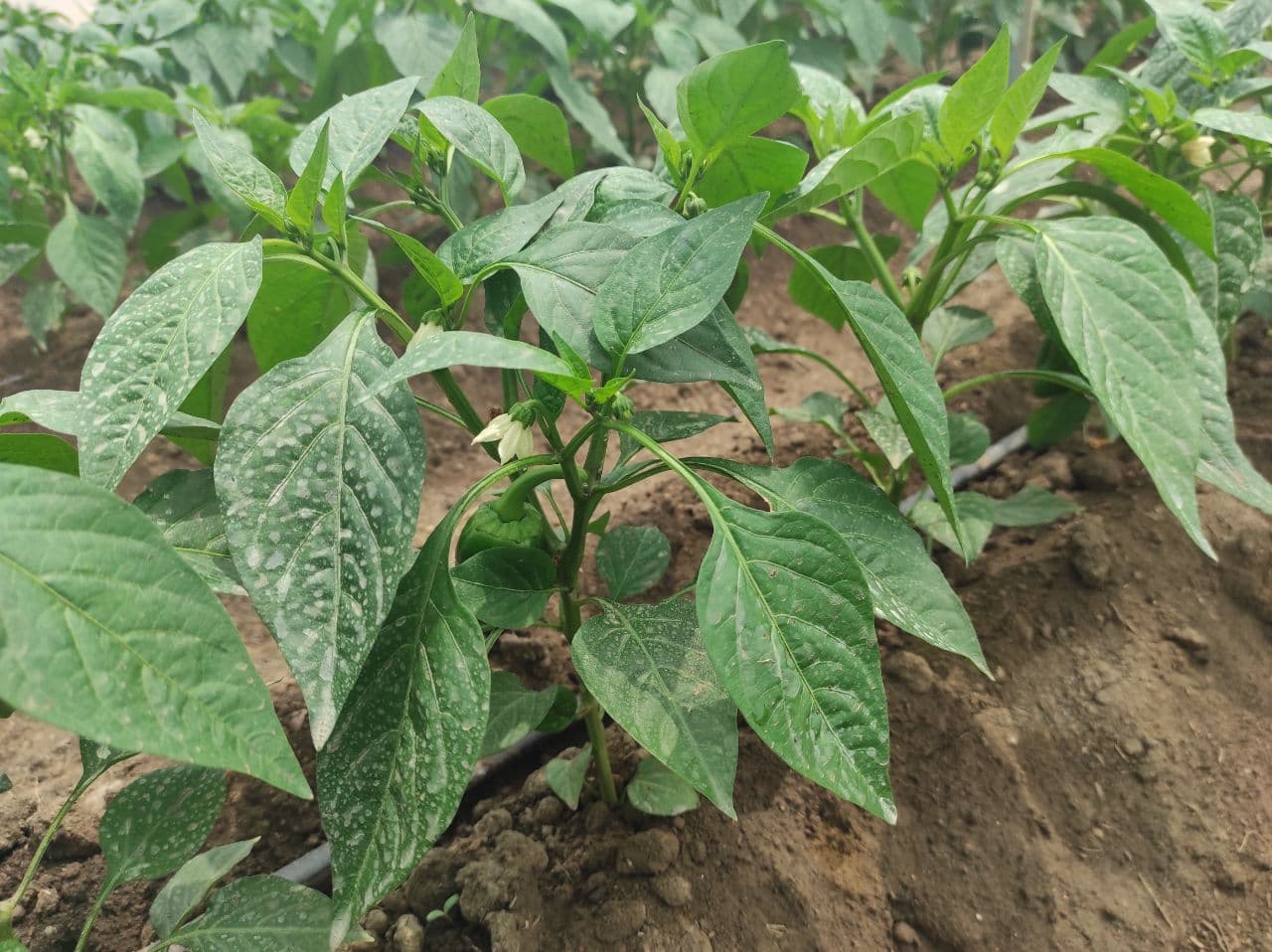
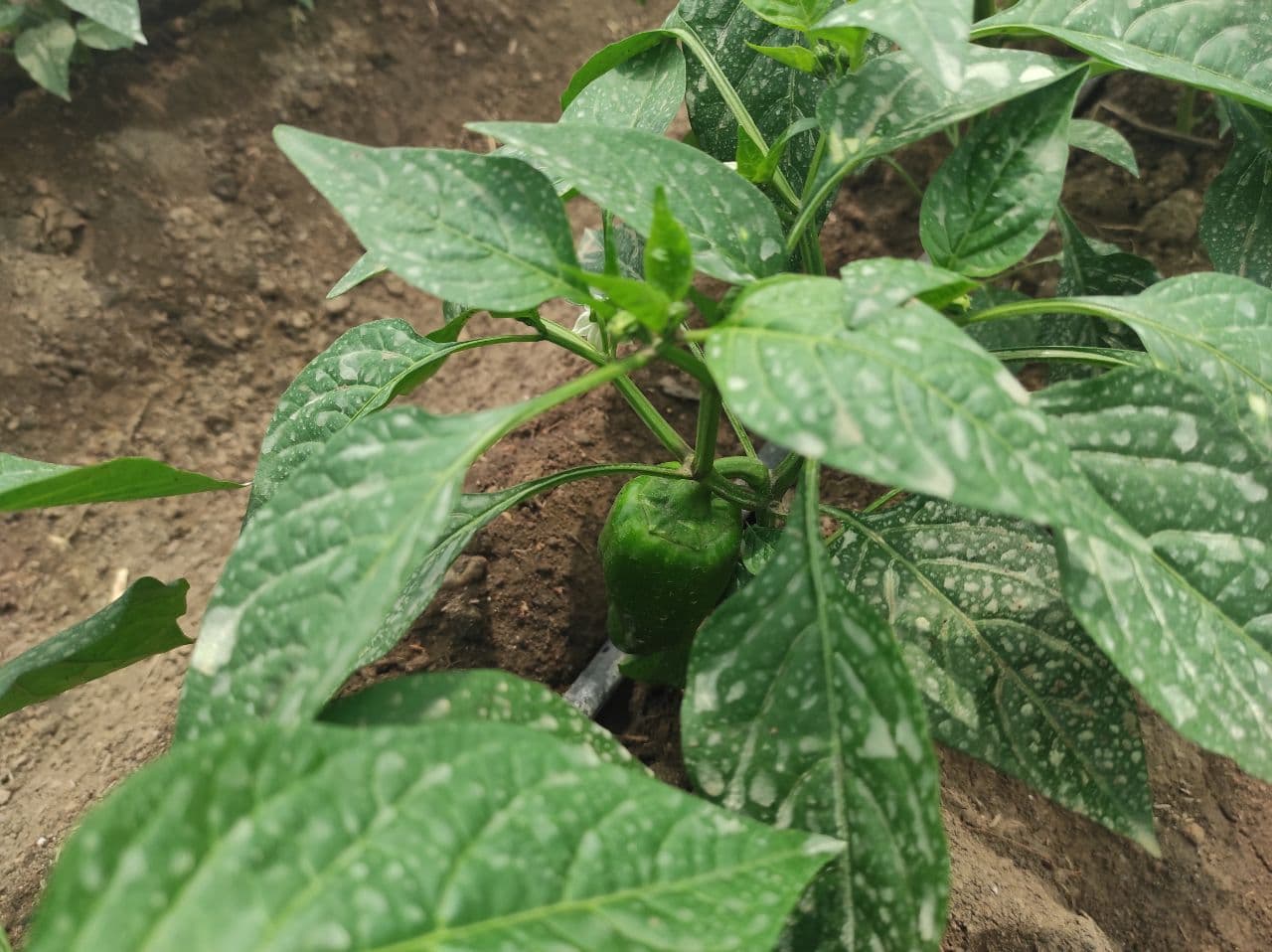
Aquí viene lo mas interesante, el interior de un invernadero operativo al 100% y con todo lo necesario para sus cosechas, el tiempo adecuado.
Sinceramente solo lo vi desde afuera una vez, pero al entrar me di cuenta lo grande que es, tiene al rededor 6500 plantas sembradas, con surcos mas separados para mayor comodidad. Las plantas suelen tener entre 12-16 frutos, es decir 12-16 cortes en todo el año, ya que se cortan un fruto de cada planta semanalmente, el resto crecerá y cambiara de color al madurarse.
¿Qué es lo increíble para mi?, pues que yo mido 171cm , y hay plantas mucho mas altas que yo, esto me pareció una locura al escucharlo no lo podía creer, tuve que verlo por mis propios ojos, incluso hay plantas que superan los 200cm (2m) y deben ser amarradas desde el techo, en las ultimas cosechas deben montarse en escaleras para poder cosechar los frutos, y en las primera cosechas cada fruto pesa al rededor de 400gr, una verdadera locura para mi pero todo esto lo comprobé con mis propios ojos.
Todo parece una pequeña selva, las plantas siempre están en constante crecimiento, y aunque les remueven algunas hojas para darle un poco mas fuerza y vida a la planta se ven abundantes, esto se debe a que el fertilizante es una solución liquida, que se le agrega directamente en el agua, todo esto va hacia la raíz y absorbe casi todo lo suministrado, el proceso para suministrarle agua es por riego con goteo, esto ahorra 3 veces mas agua que una plantación a campo abierto, y además el tamaño de las los pimentones en una plantación abierta es mucho menor.
Las hojas son del tamaño de una palma de mi mano.
Here comes the most interesting part, the inside of a greenhouse 100% operational and with everything you need for your crops, the right time.
Honestly I only saw it from the outside once, but when I entered I realized how big it is, it has around 6500 plants planted, with furrows more separated for more comfort. The plants usually have between 12-16 fruits, that is 12-16 cuttings throughout the year, since one fruit is cut from each plant weekly, the rest will grow and change color as it ripens.
What is incredible for me, I am 171cm tall, and there are plants much taller than me, this seemed crazy to me when I heard it I could not believe it, I had to see it with my own eyes, there are even plants that exceed 200cm (2m) and must be tied from the roof, in the last harvests must be mounted on ladders to harvest the fruits, and in the first harvest each fruit weighs about 400gr, a real madness for me but all this I checked with my own eyes.
Everything looks like a small jungle, the plants are always in constant growth, and although they remove some leaves to give a little more strength and life to the plant they look abundant, this is because the fertilizer is a liquid solution, which is added directly into the water, all this goes to the root and absorbs almost everything supplied, the process to supply water is drip irrigation, this saves 3 times more water than an open field plantation, and also the size of the peppers in an open plantation is much smaller.
The leaves are the size of the palm of my hand.
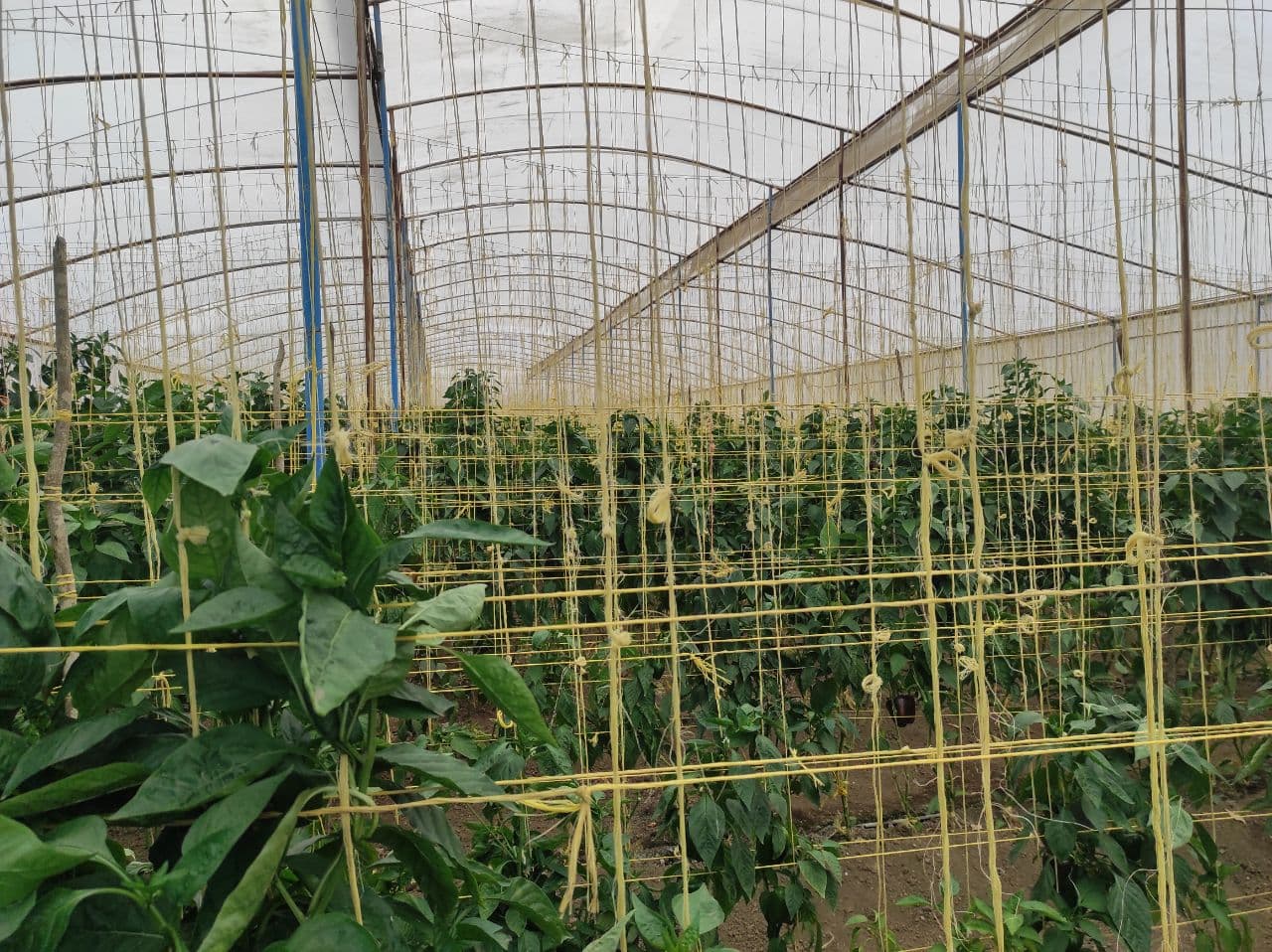

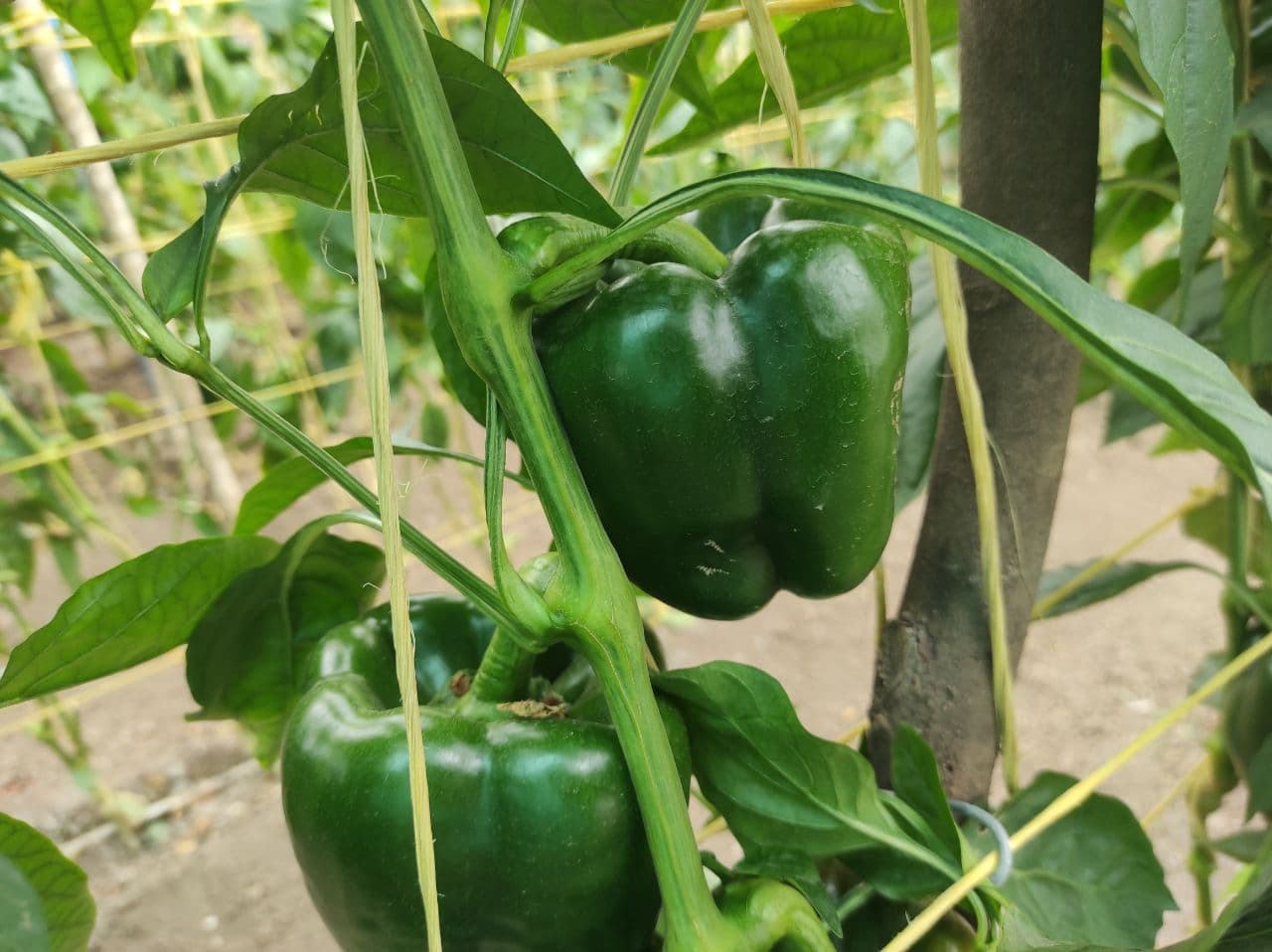
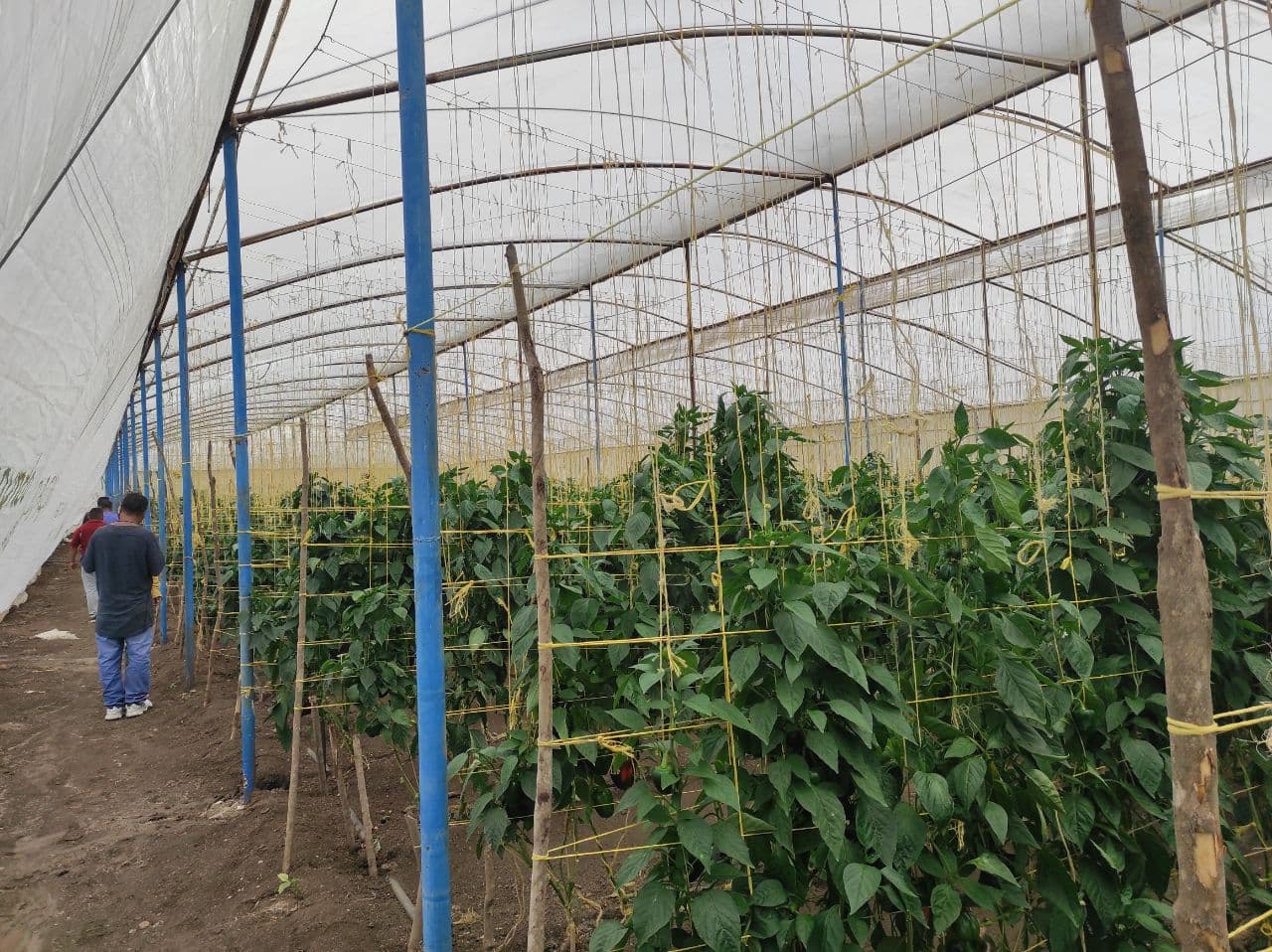
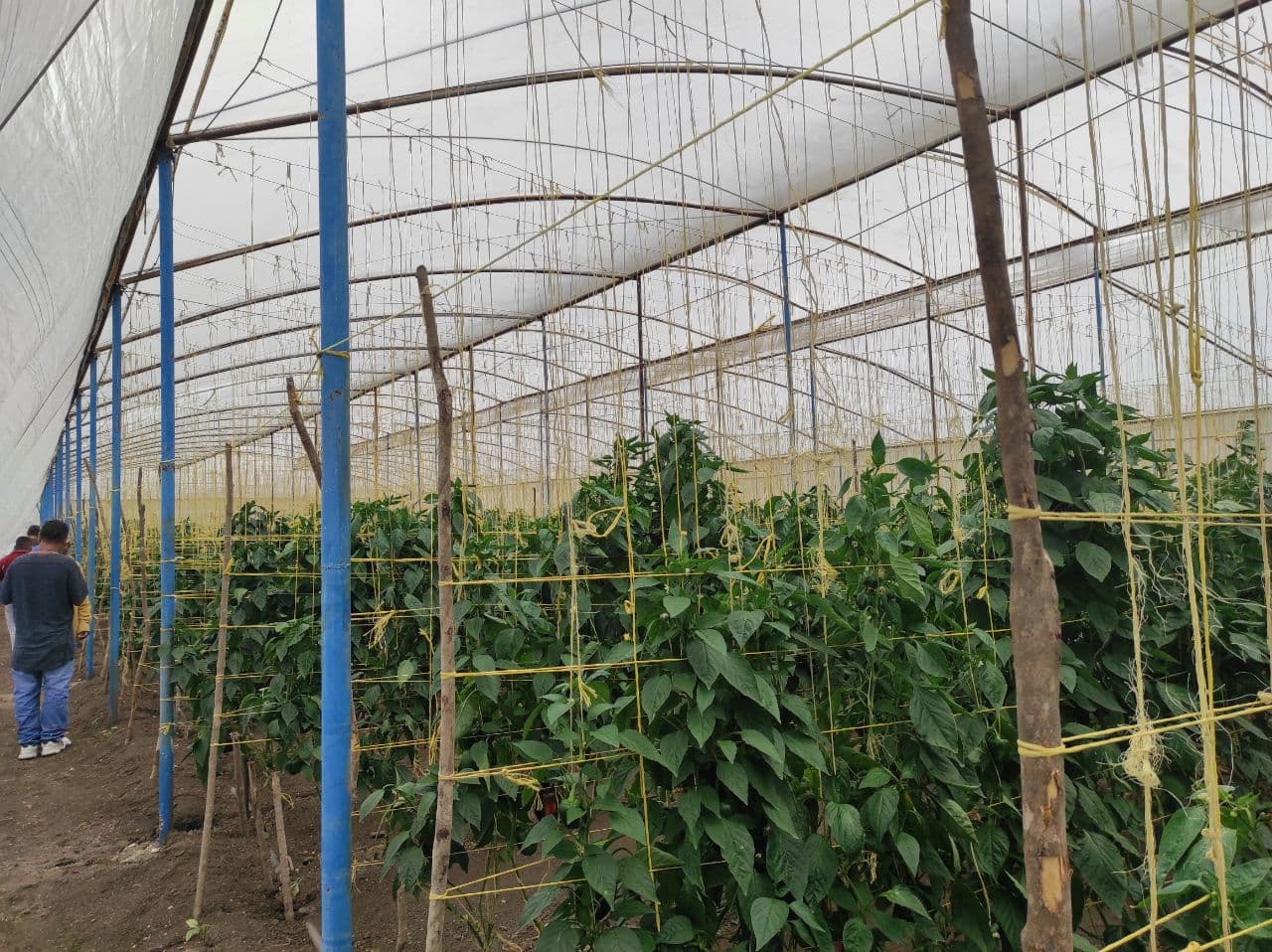
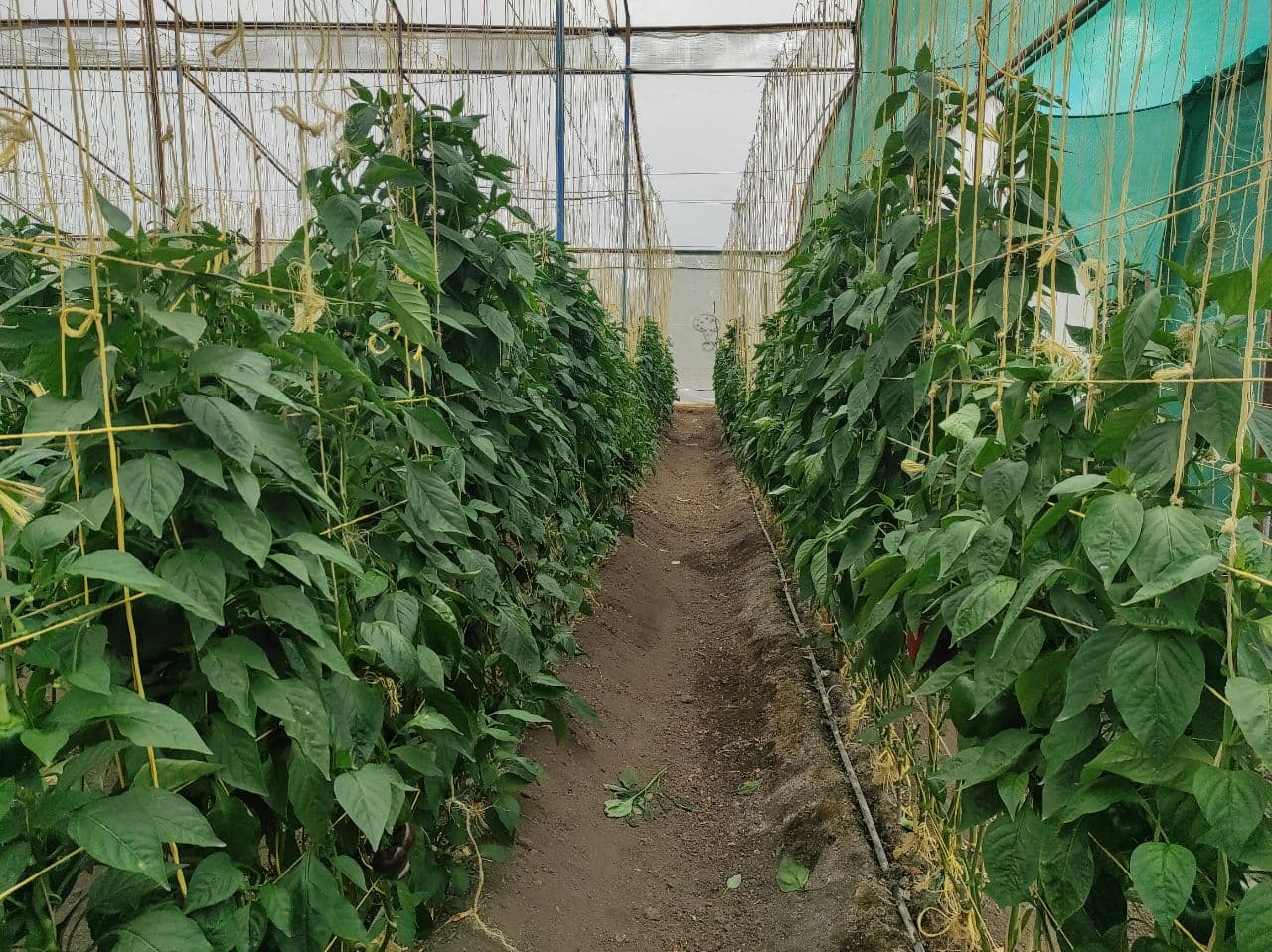
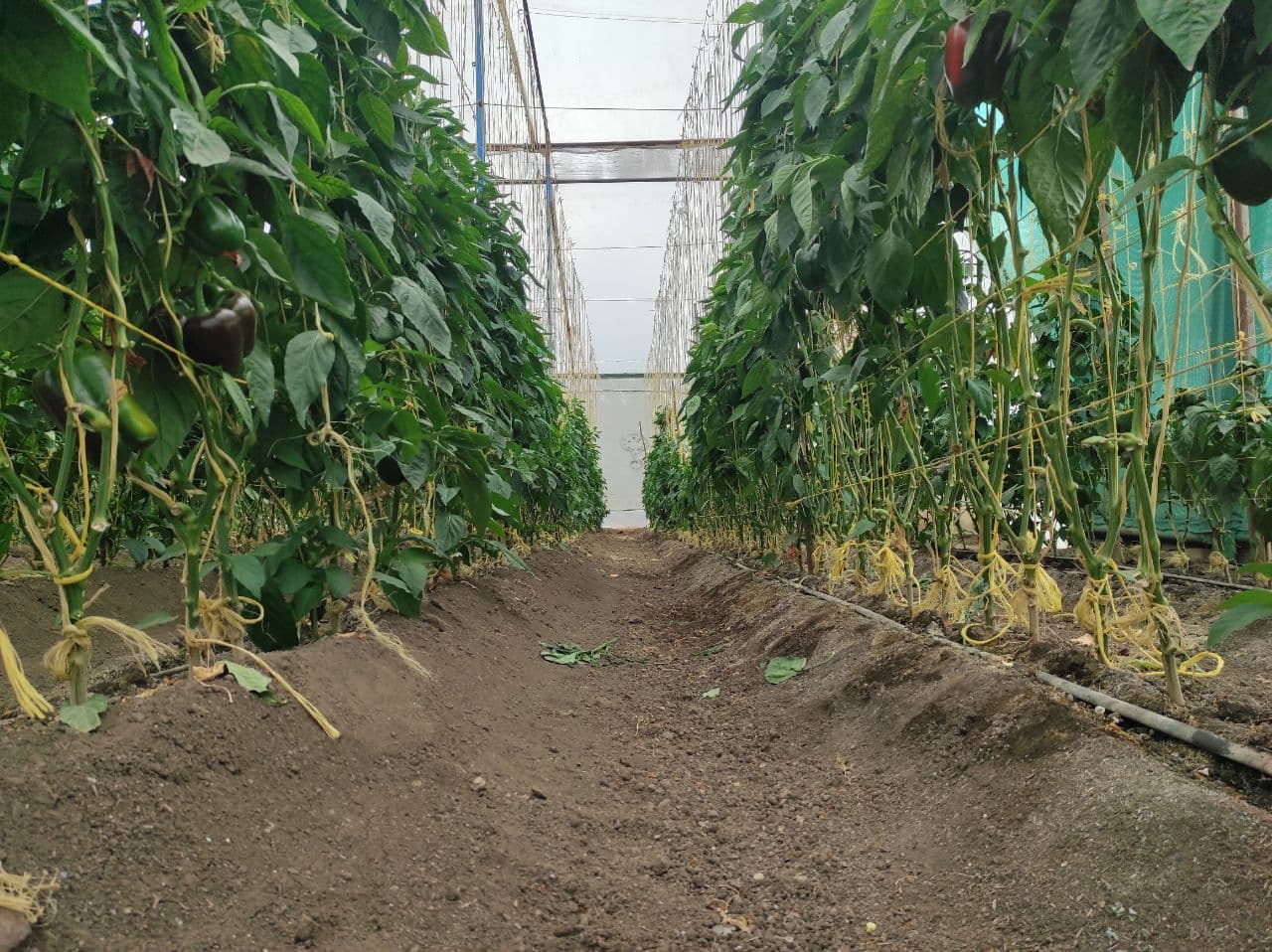
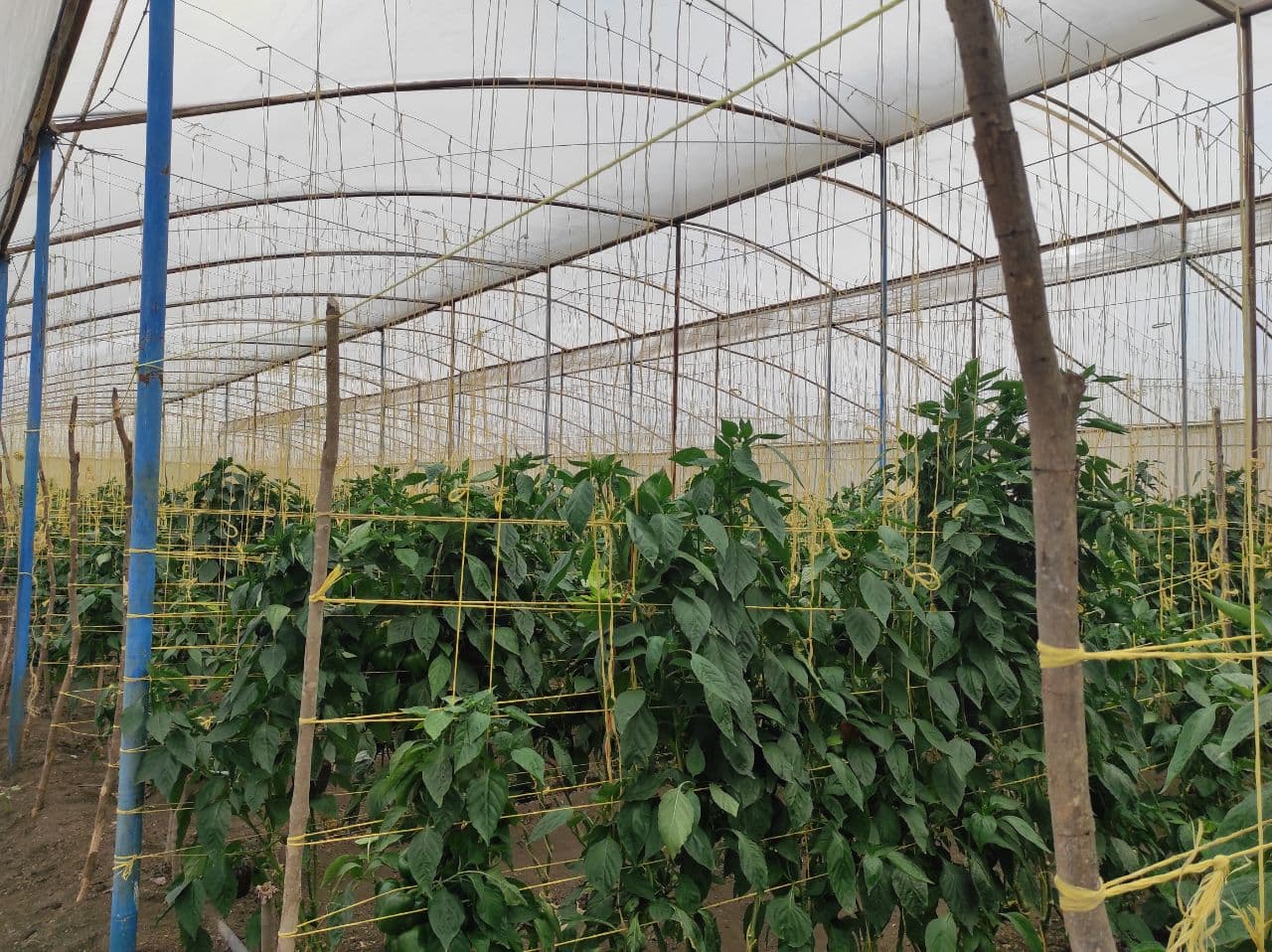
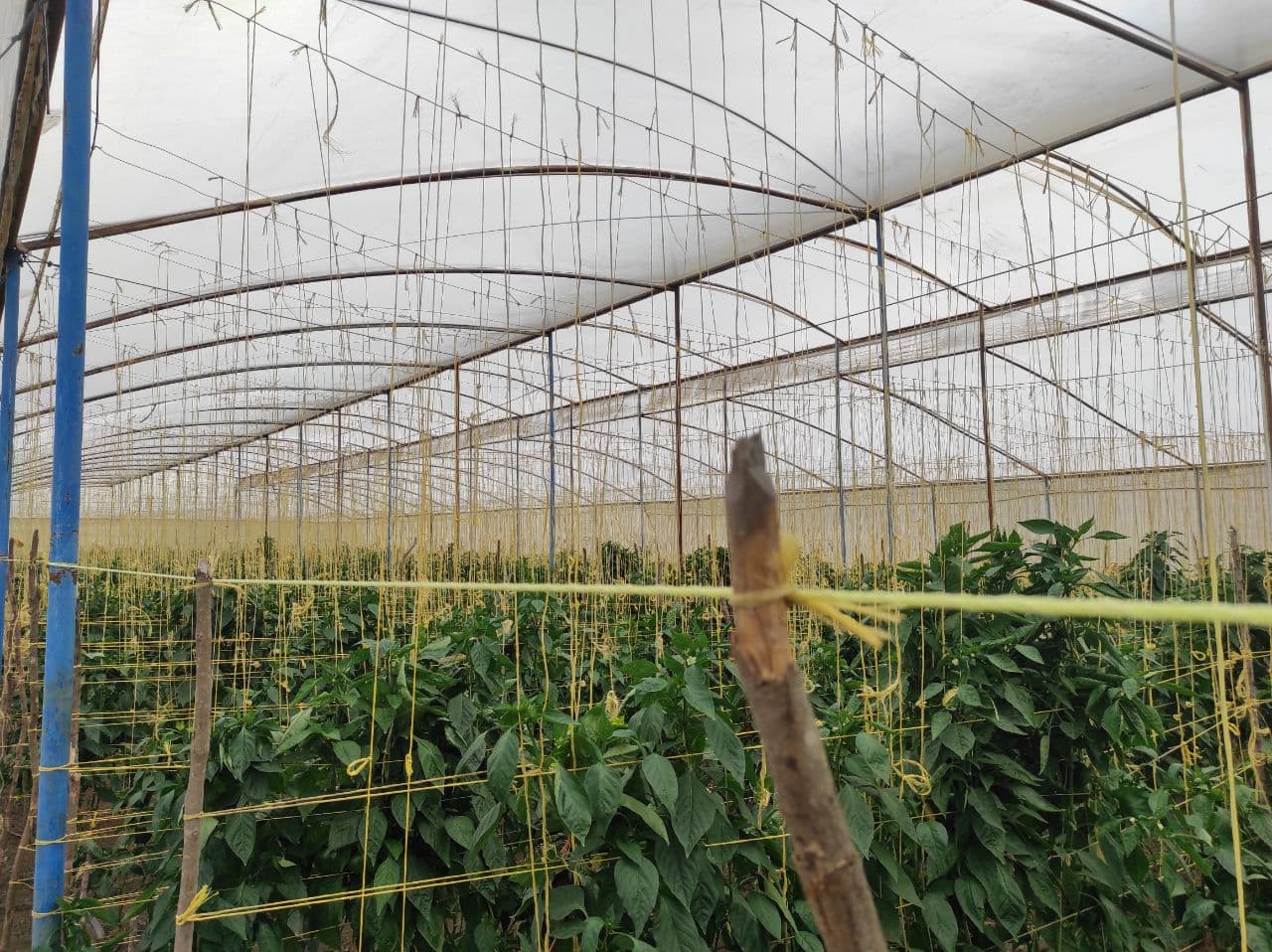

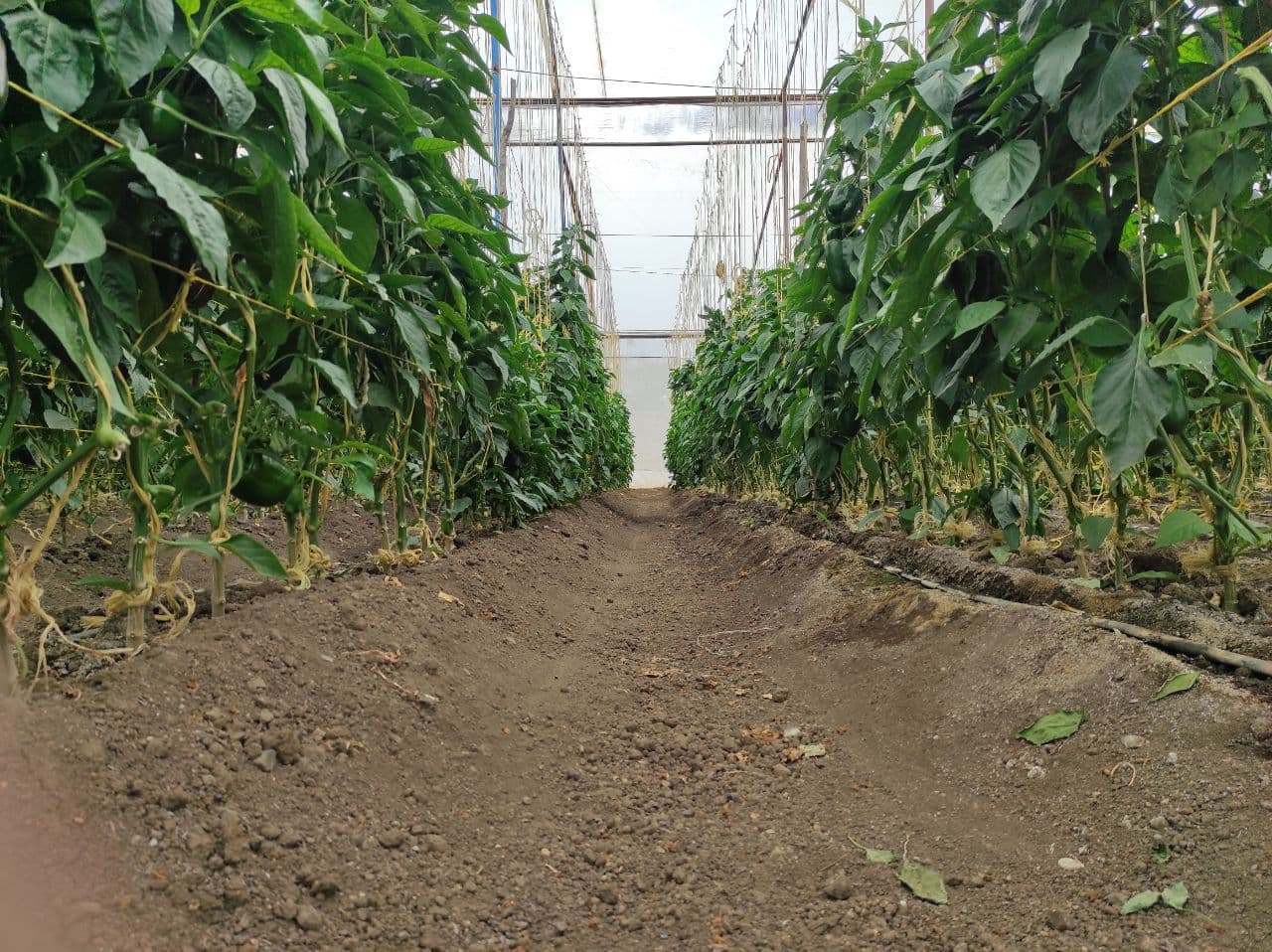
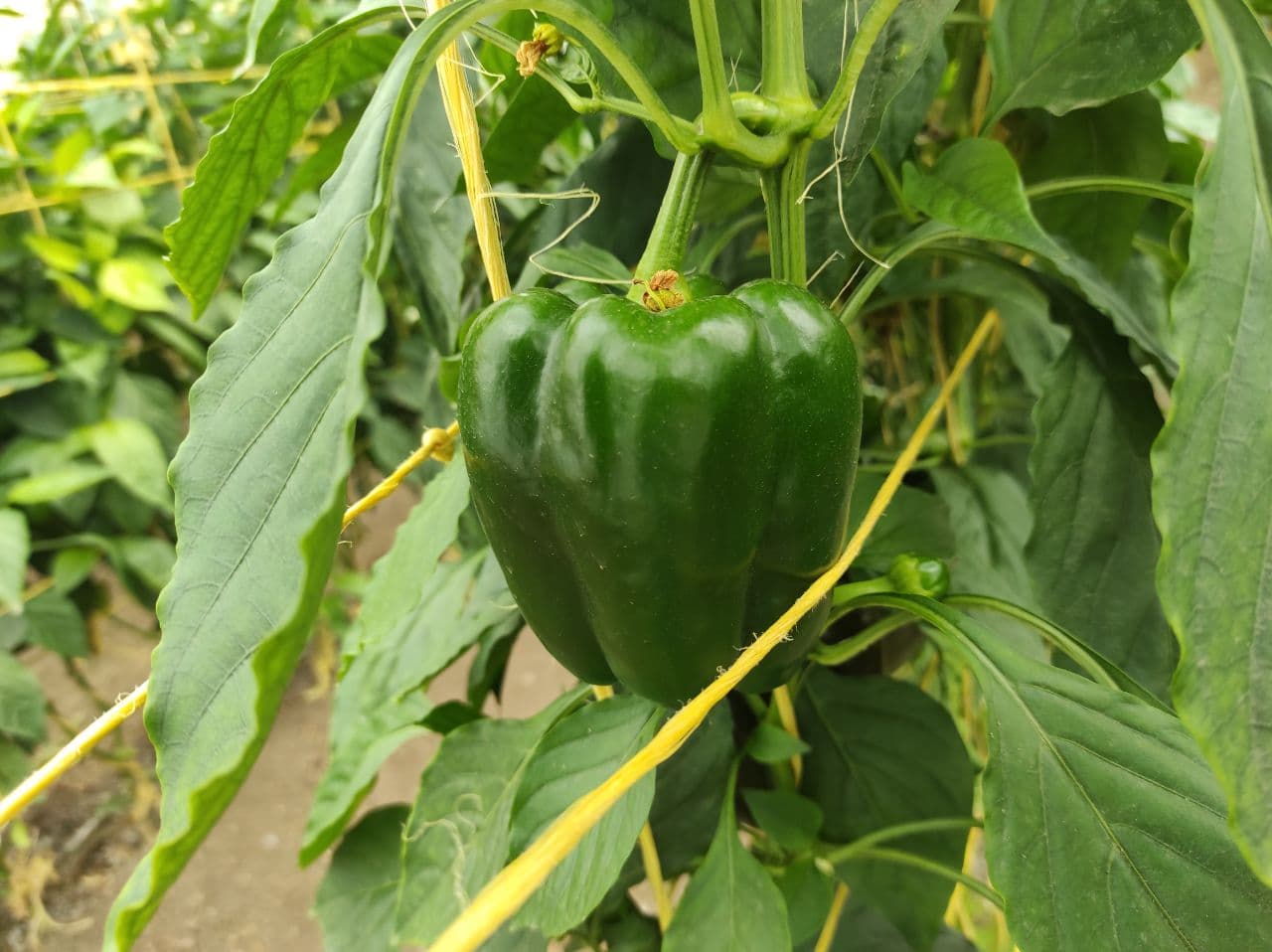
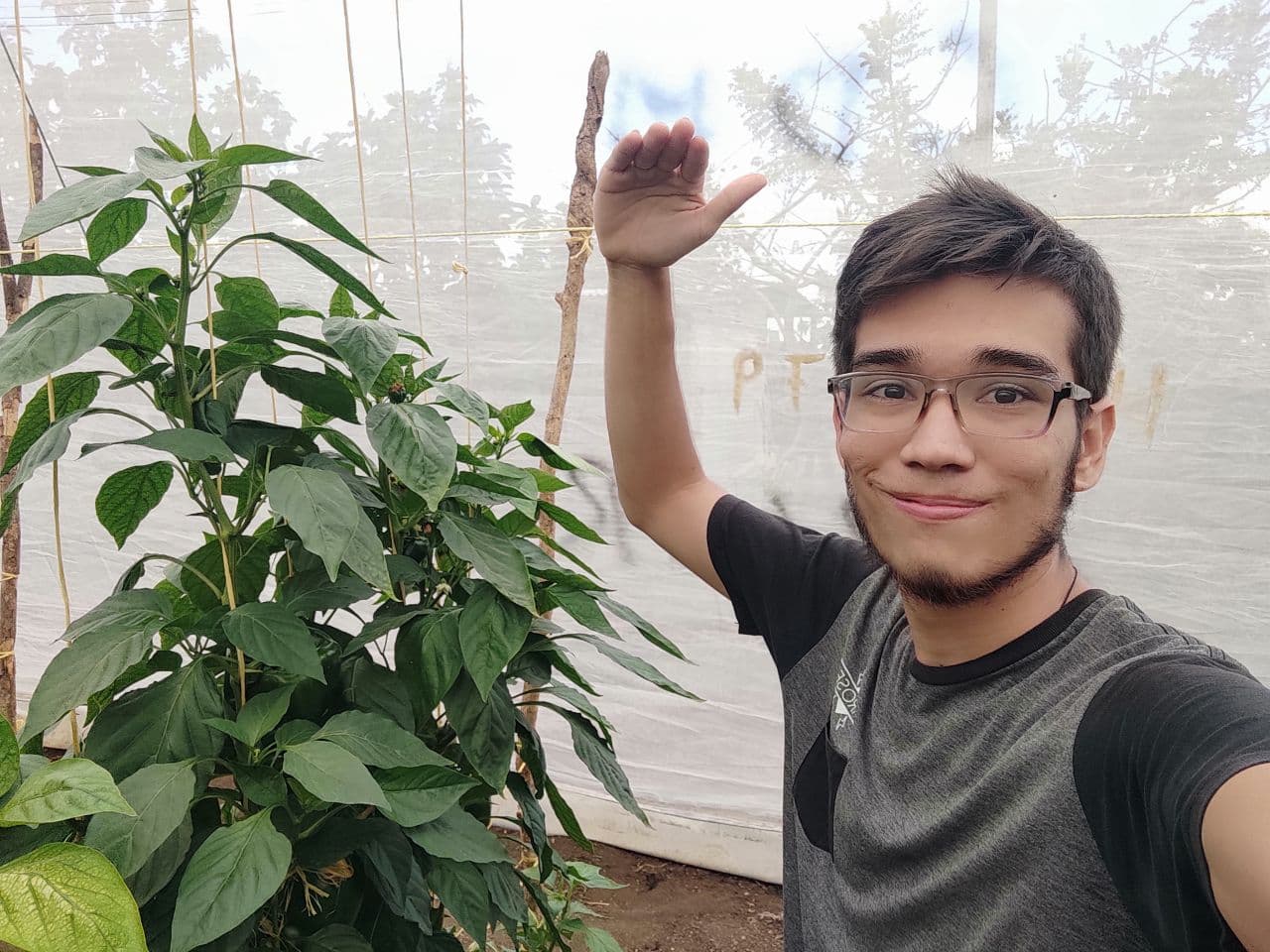
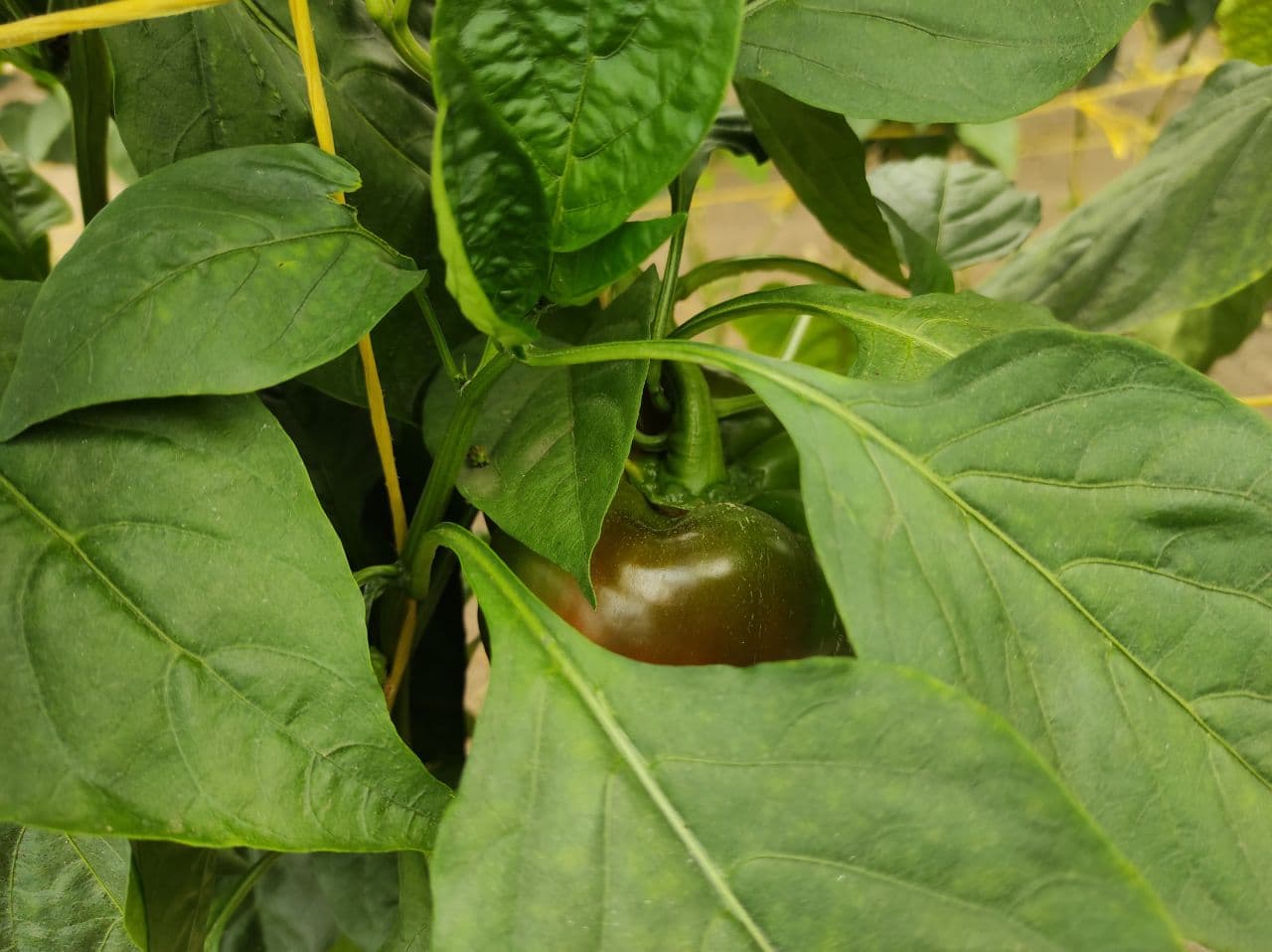
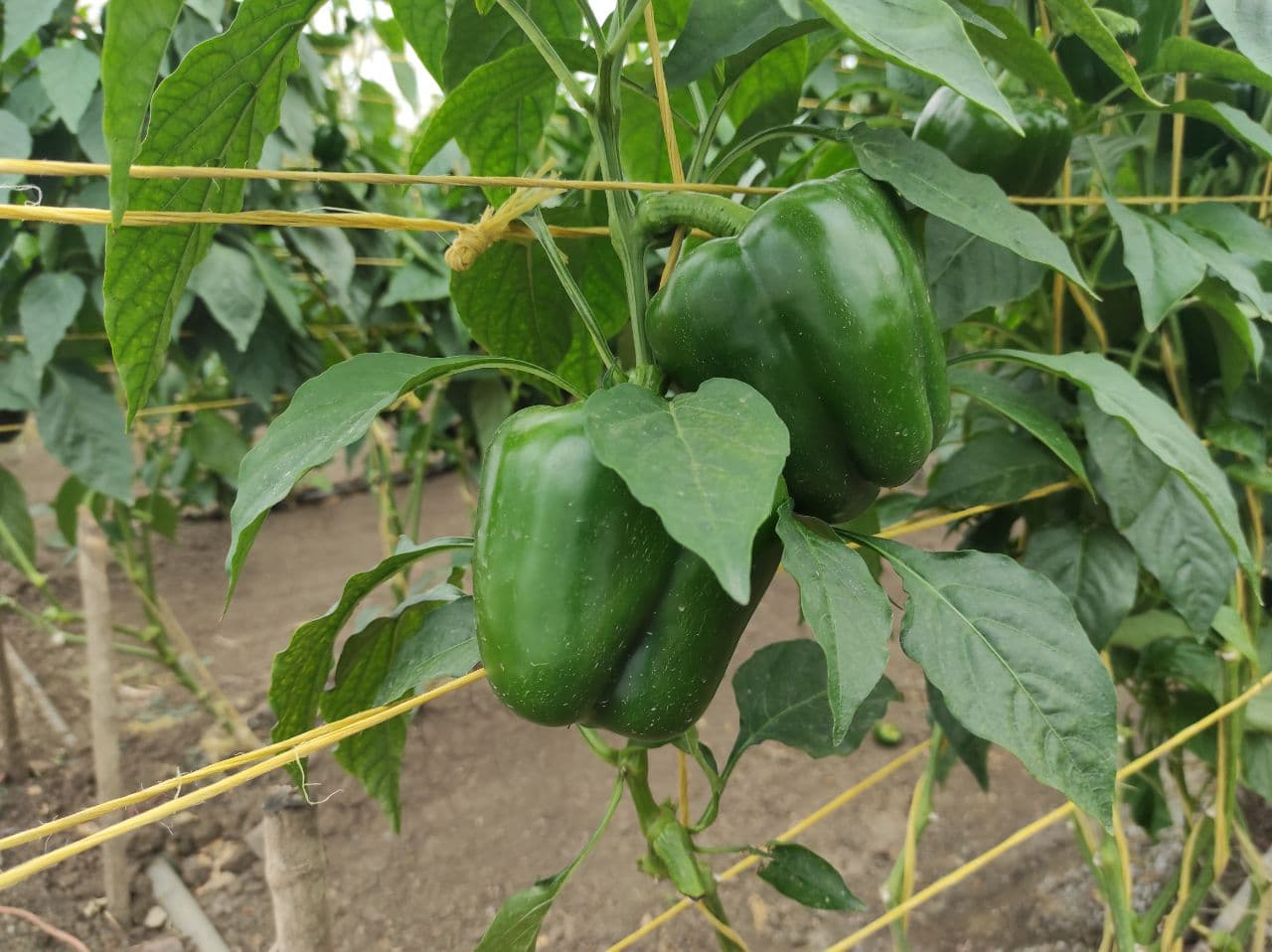




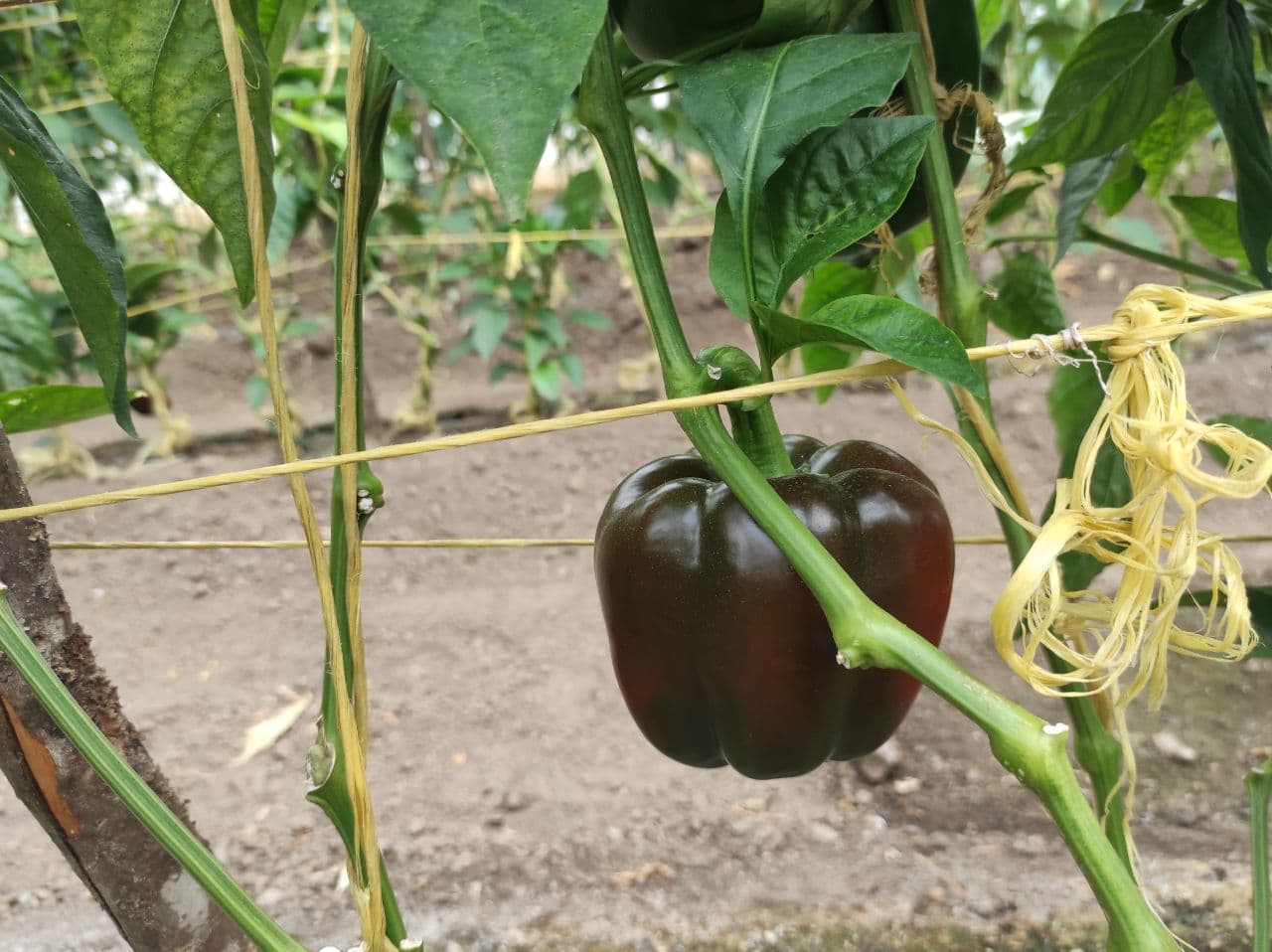
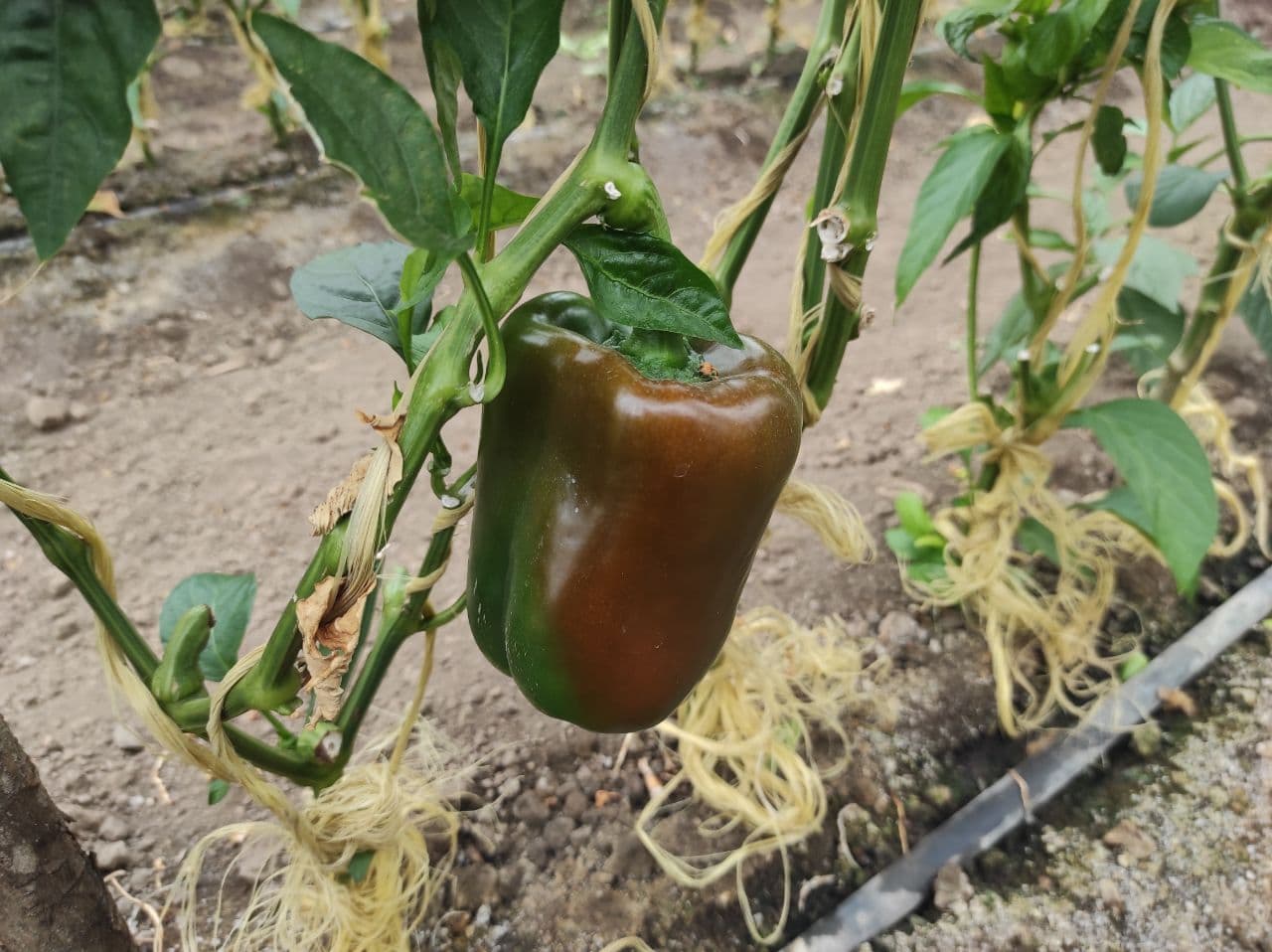
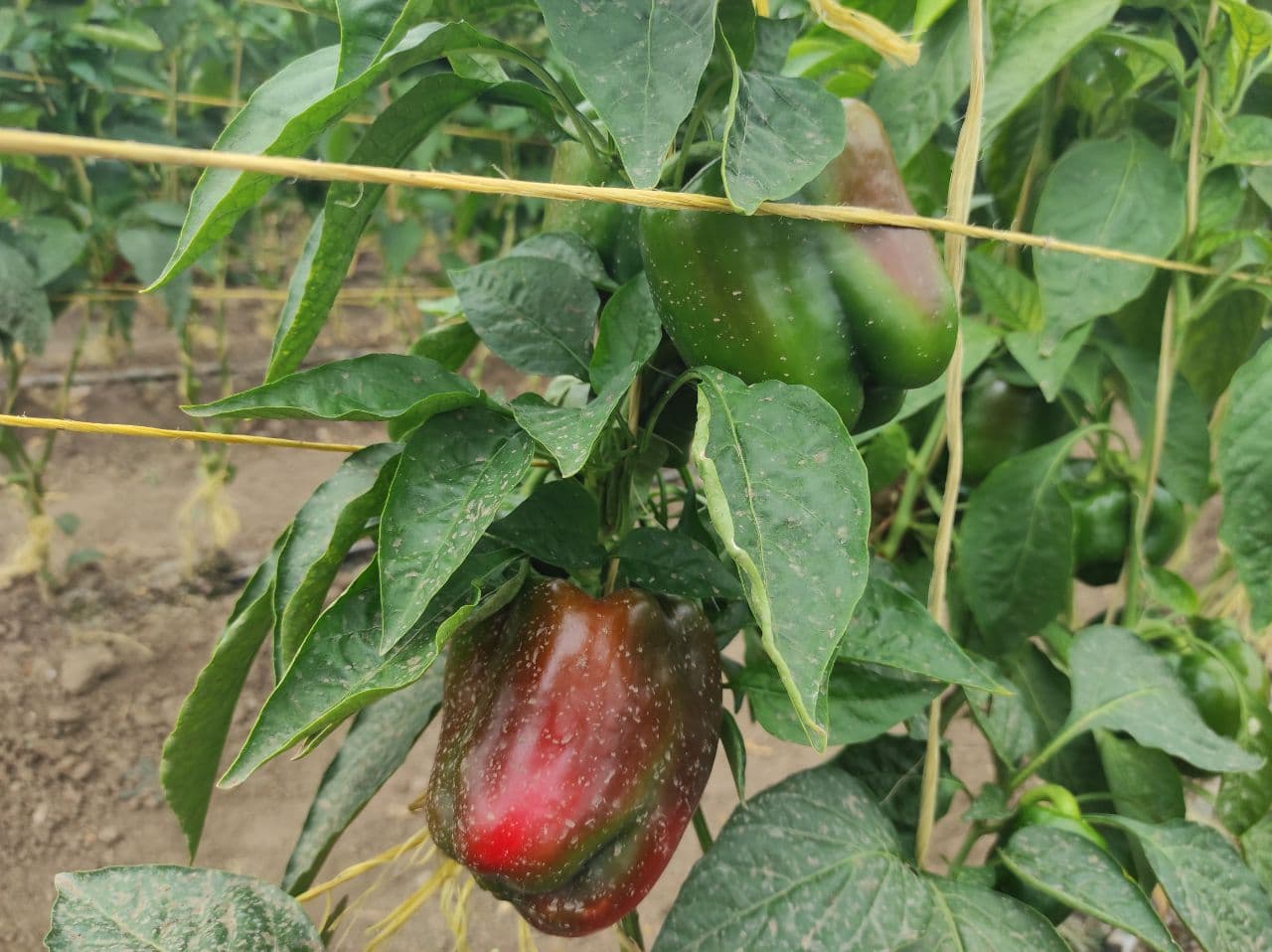
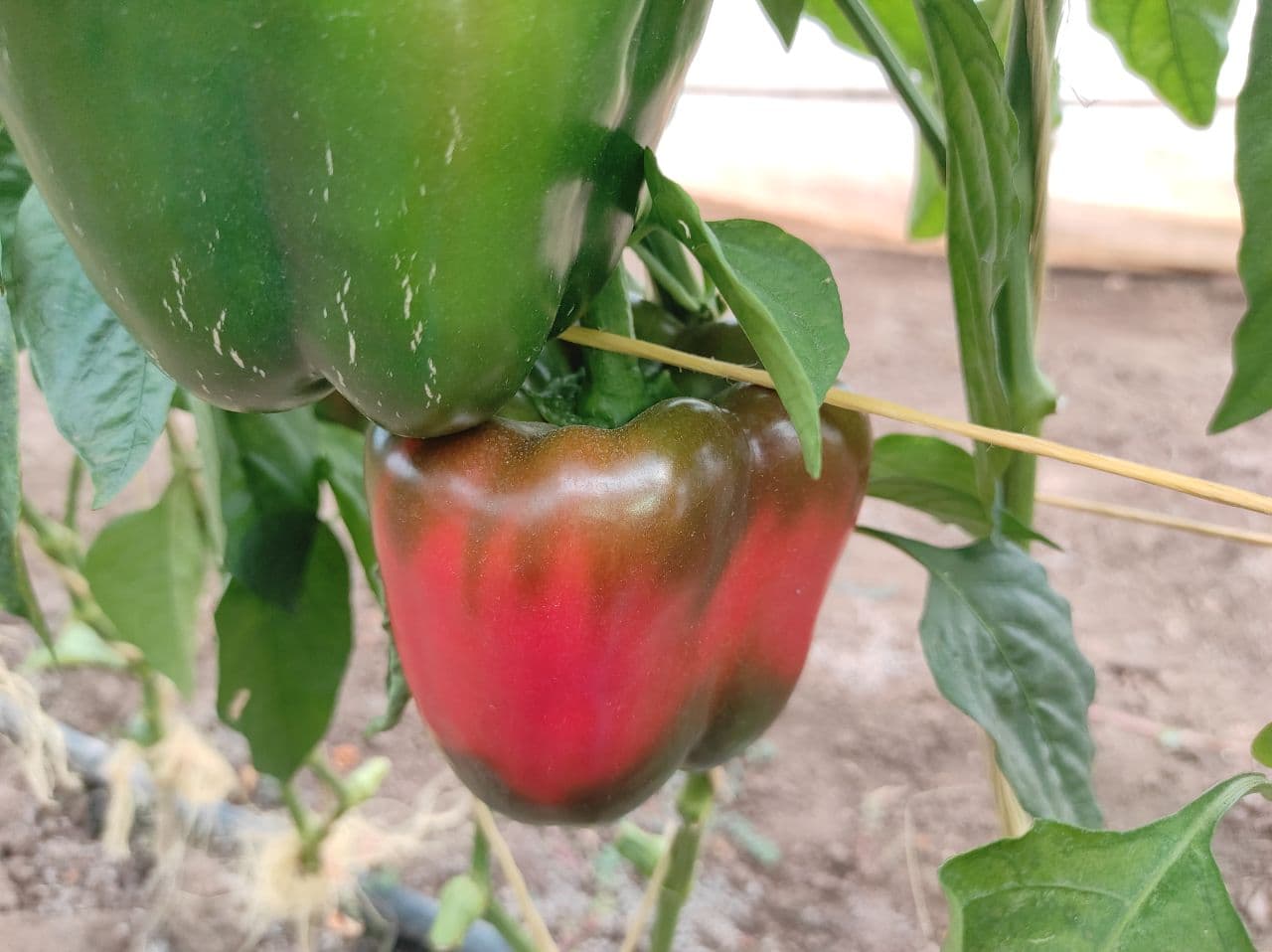
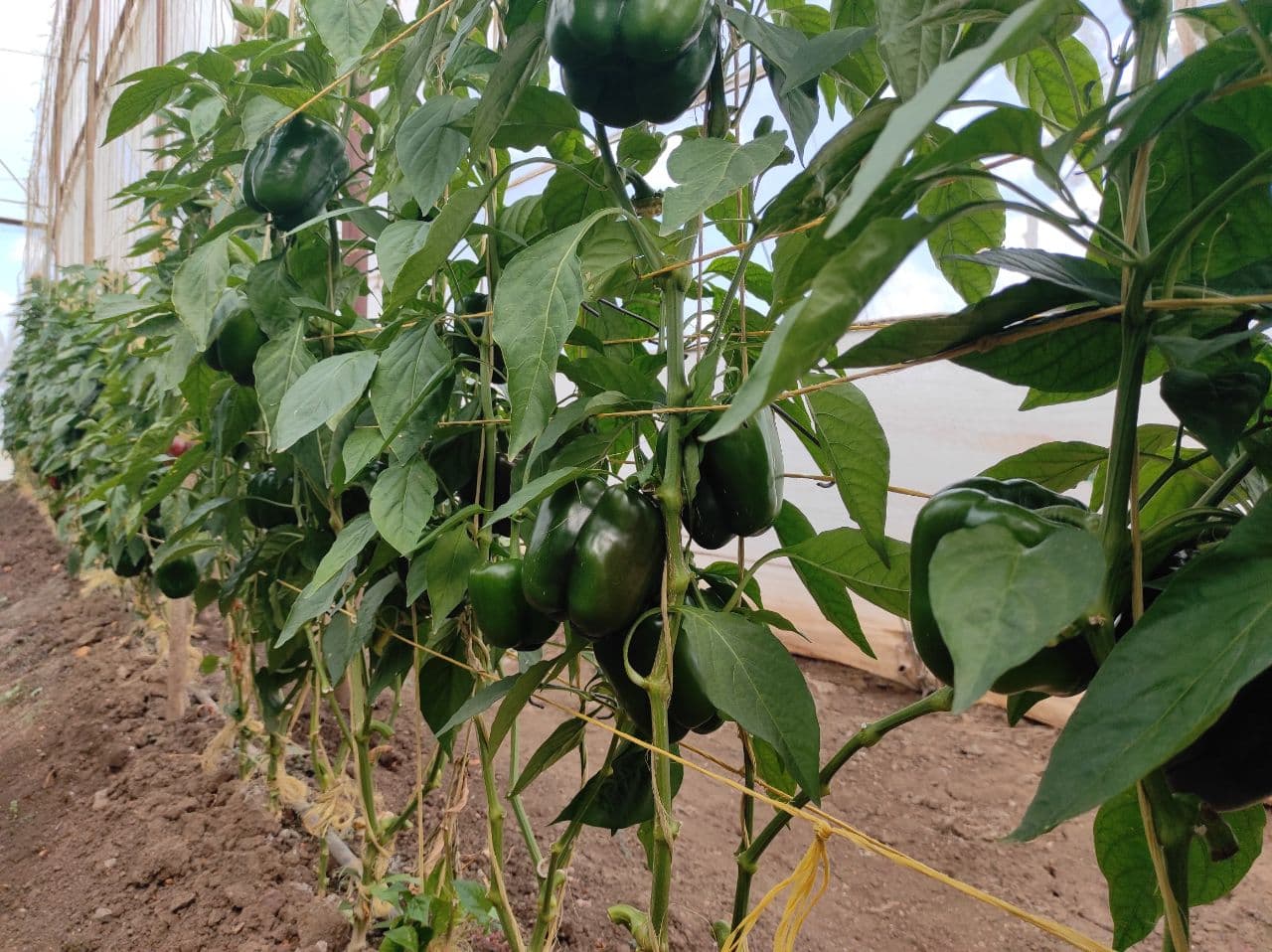
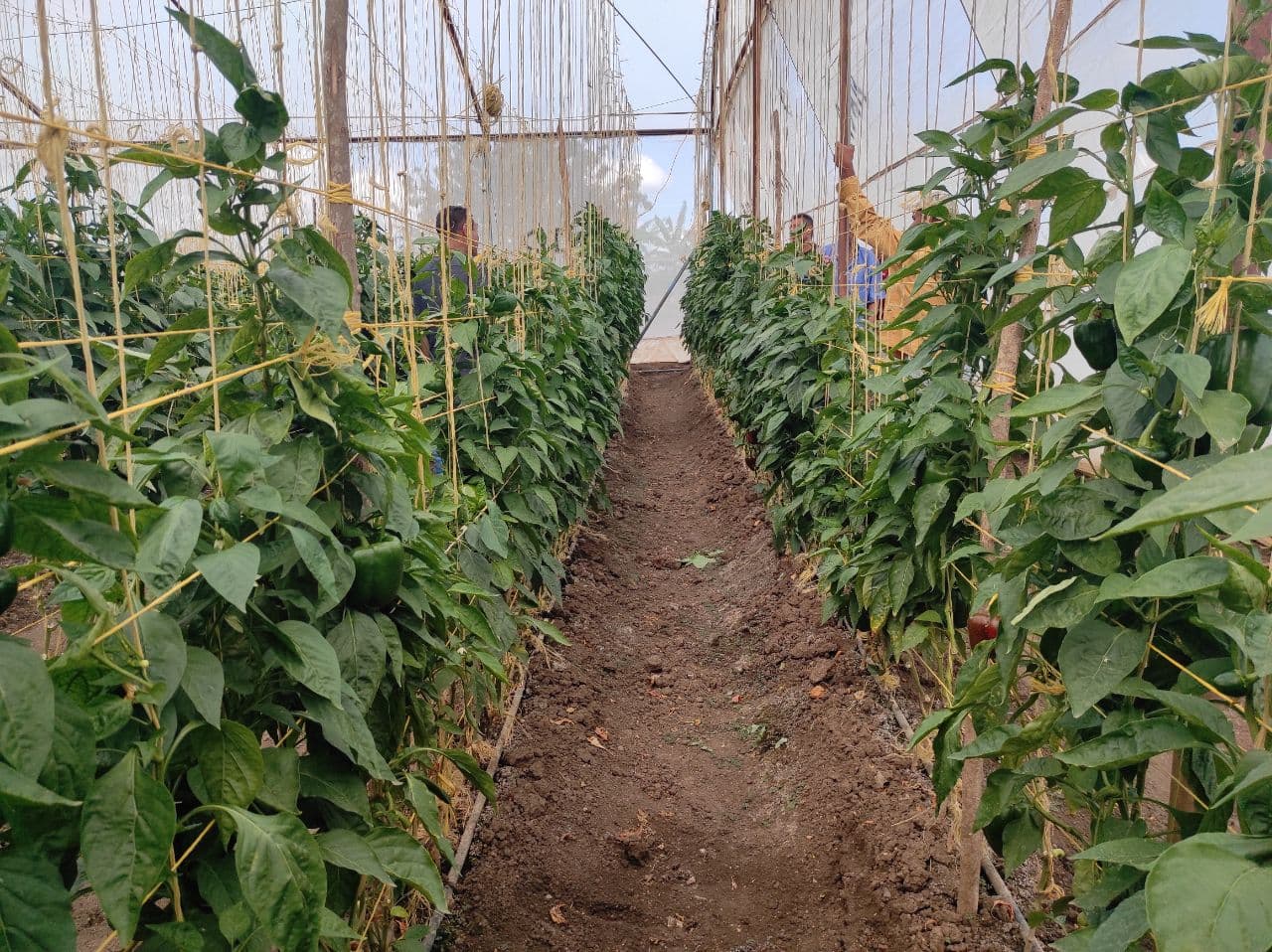
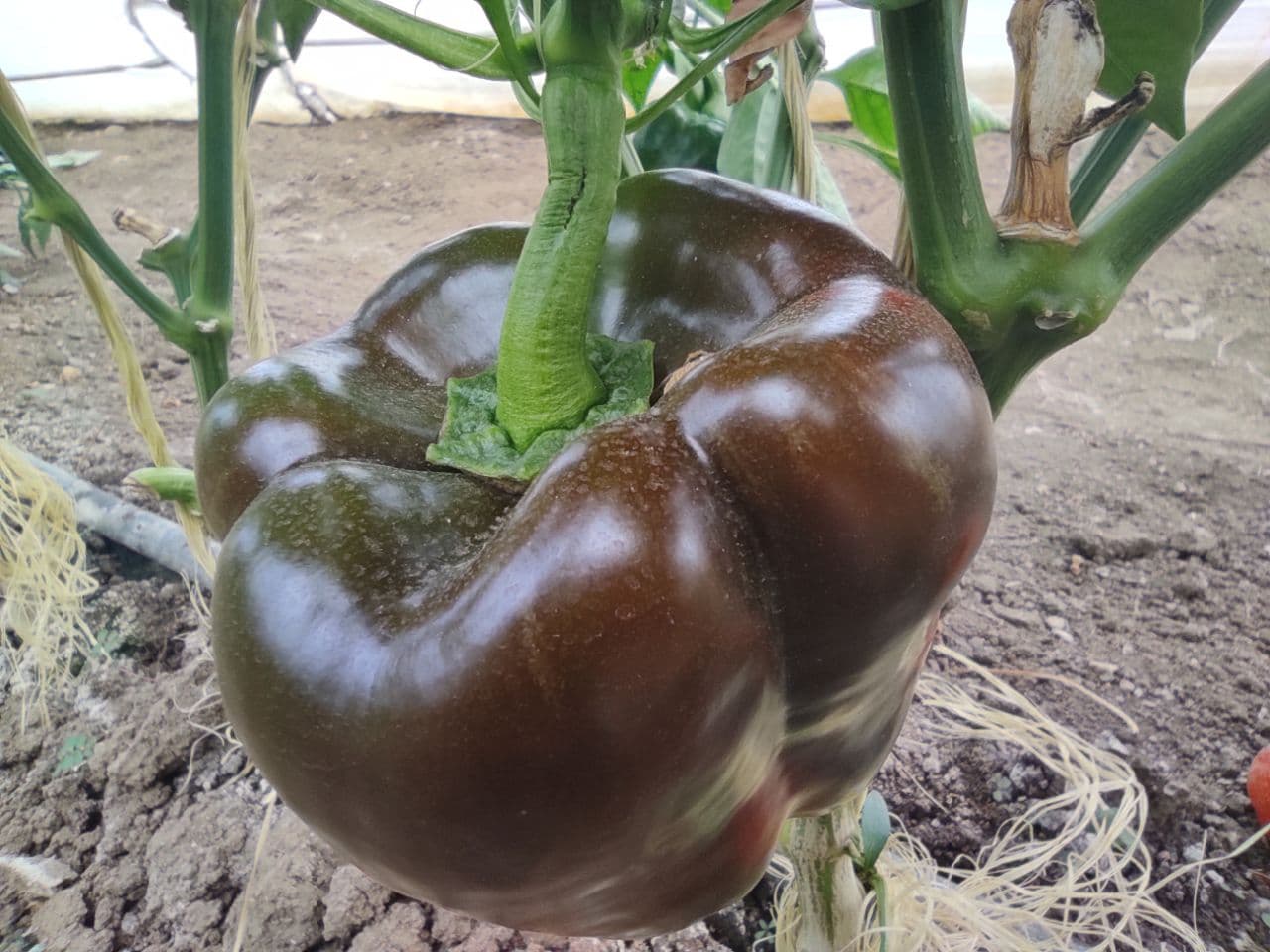
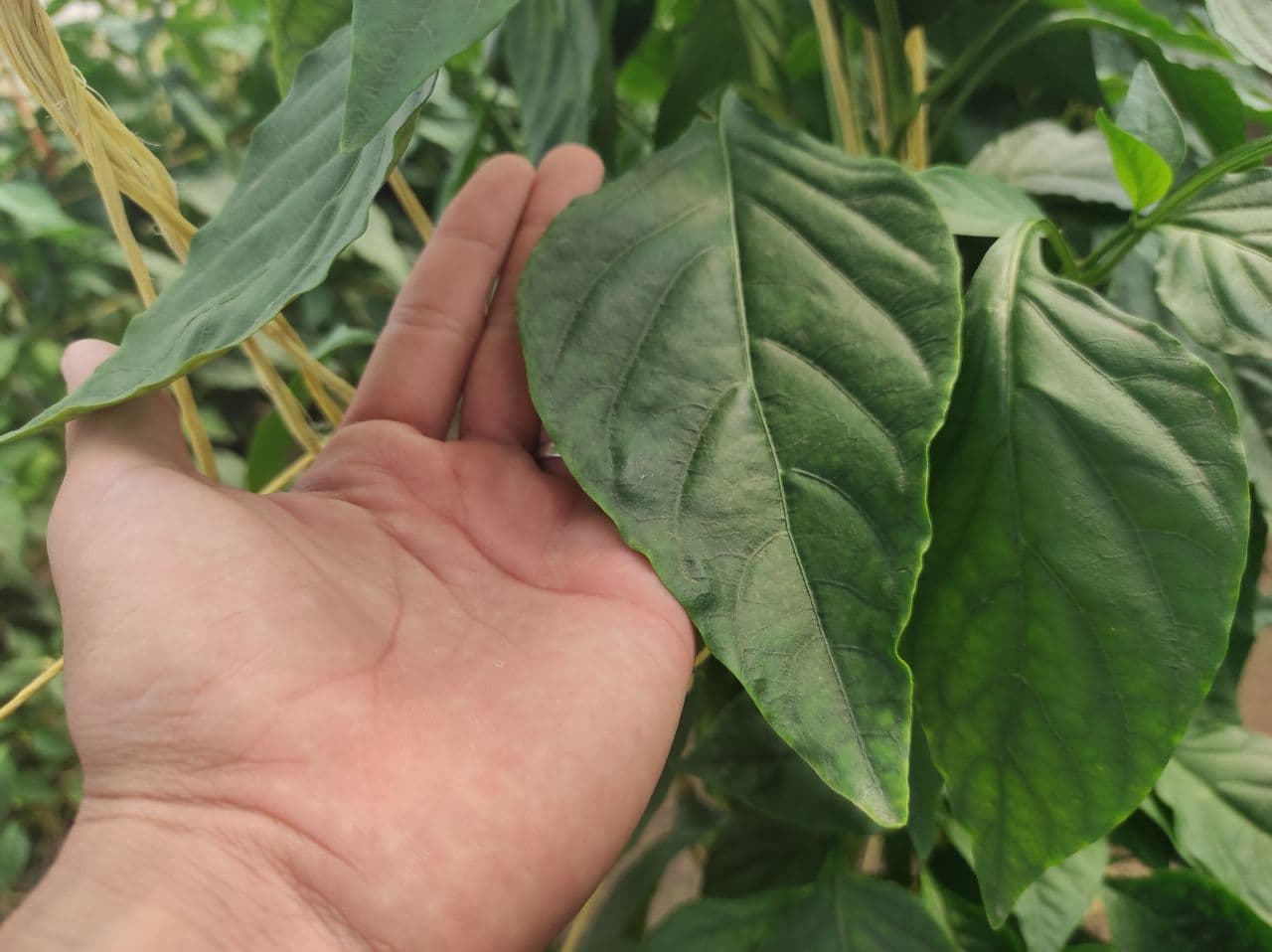
Como verán hay diferentes tamaños, colores y tonalidades, pero sin duda alguna estos pimentones son mucho mas grandes que los que había visto en cualquier otro mercado.
La verdad fue interesante ver todo este proceso desde el interior, ver como funciona todo y literalmente saber que si existen plantas que miden 2m de altura, sin duda alguna las plantaciones en un ambiente controlado son mejores por mucho, y mas cuando utilizas fertilizantes y materiales orgánicos.
Nuestro proyecto comienza desde 0, simplemente la estructura en pie, debemos comprar malla, mangueras, cintas y sistema de riego, esperamos tener todo listo para el Jueves o Viernes y poder tener todo plantado antes del Sábado, estoy muy entusiasmado con esto y espero poder contarles y mostrarles como ira todo con el pasar de los días.
As you can see there are different sizes, colors and shades, but without a doubt these peppers are much bigger than the ones I had seen in any other market.
The truth was interesting to see all this process from the inside, see how everything works and literally know that if there are plants that measure 2m high, without a doubt the plantations in a controlled environment are better by far, and more when you use fertilizers and organic materials.
Our project starts from 0, just the standing structure, we must buy mesh, hoses, tapes and irrigation system, we hope to have everything ready for Thursday or Friday and to have everything planted before Saturday, I am very excited about this and I hope to tell you and show you how everything will go with the passing of the days.
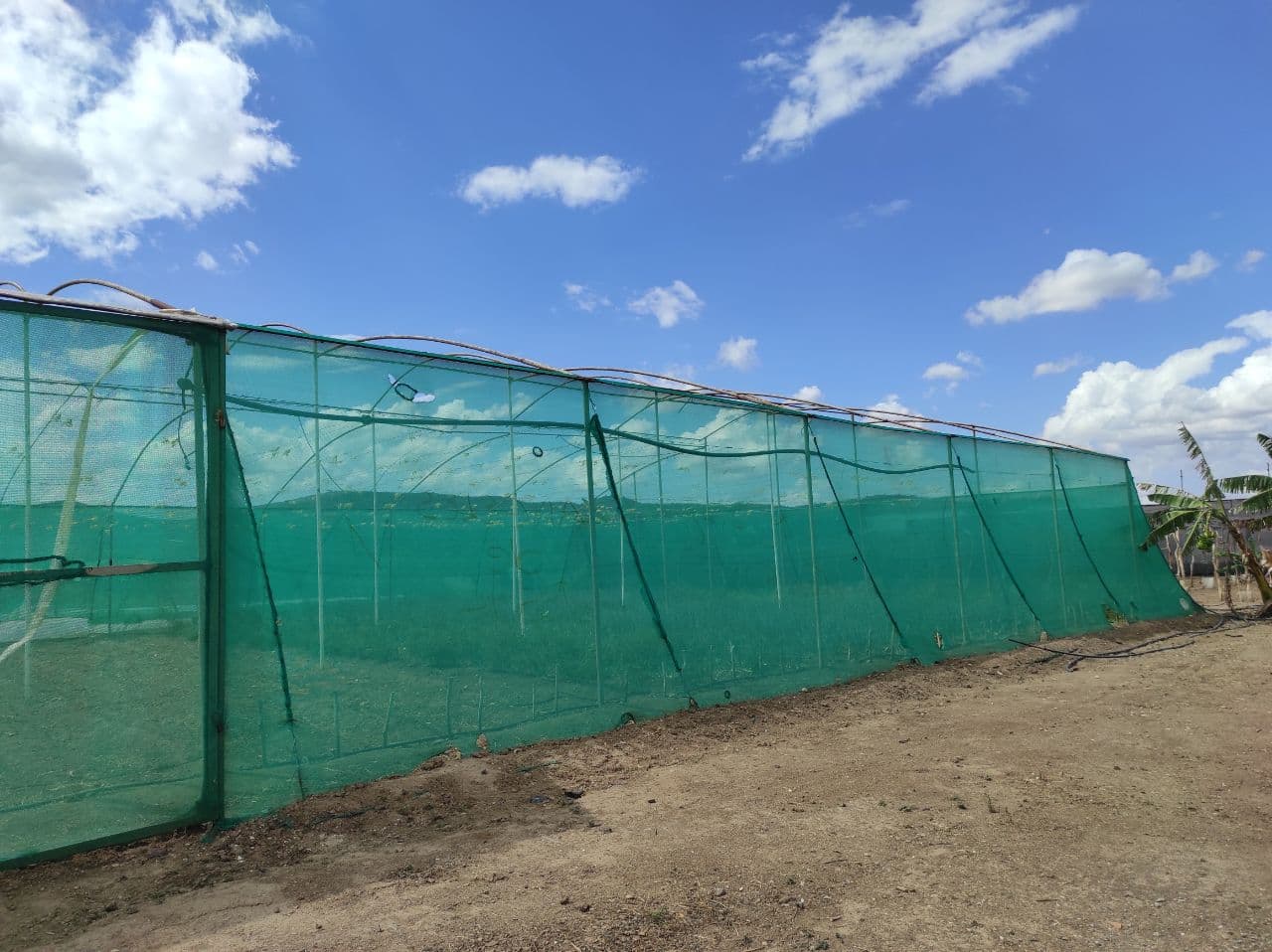
Congratulations @wesp05! You have completed the following achievement on the Hive blockchain and have been rewarded with new badge(s) :
Your next target is to reach 500 posts.
You can view your badges on your board and compare yourself to others in the Ranking
If you no longer want to receive notifications, reply to this comment with the word
STOPCheck out the last post from @hivebuzz:
That was detailed :)
Thanks for sharing and your effort in contributing to Photography Lovers community.
Many thanks to you for the support, and for taking a look at my post :D
You should try the naturalmedicine tag as well.
Its okay, thank you :D
Oh, espectacular!
Graciaaas <3
Cuando cosechen debes hacer muchas recetas con pimentón jejeje
Jajajajajajajaja no lo dudes😂
Felicitaciones, me pareció un post muy didáctico para el que quiera emprender una siembra de esta hortaliza tan demandada en la cocina, tengo poco tiempo en Hive y te invito a visitar mi blog cuando gustes, éxitos !
Gracias por pasarte por aquí, esta bien visitare pronto tu blog.
This is such a awsome post, really Great details and amazing pictures.
Growing things and see the process is fascinating and I only just got myself a Green house so I am excited to start growing things in there 😉
Really amazing to read, Thank you for sharing 🙏 inspiering.
Have a wonderful week. Cheers!
Thanks so much for seeing my post, coincidentally I just saw yours haha, I envy you for visiting the Viking fortress.
You are welcome, it was a plessure to read your post 😉
Glad you liked mine to and I am sure you Will see a Viking place some Day, or I send you one 😁 lol